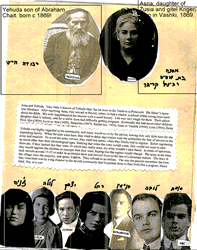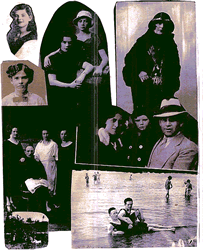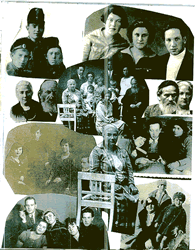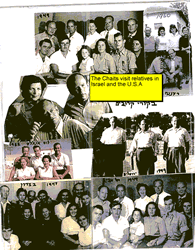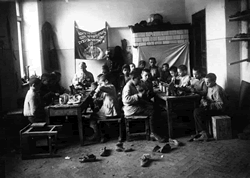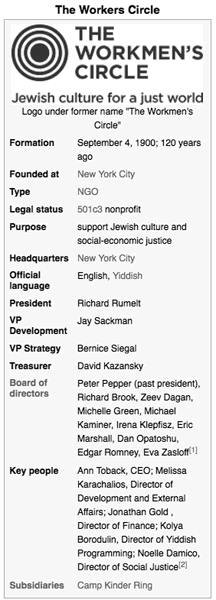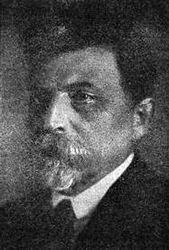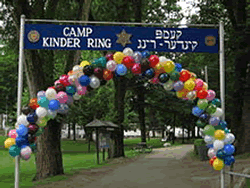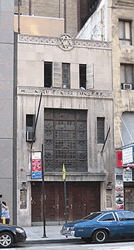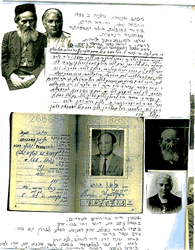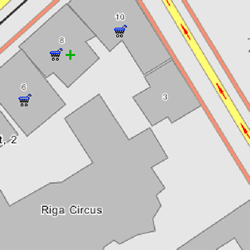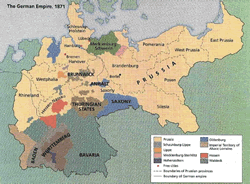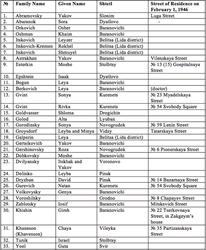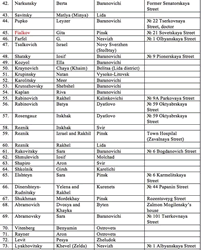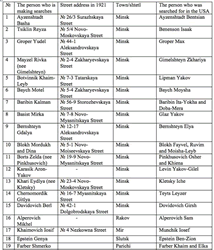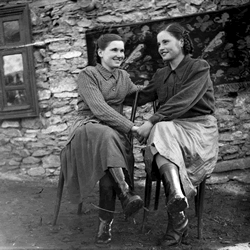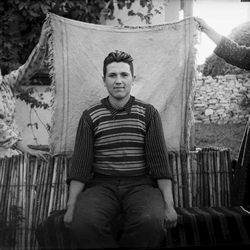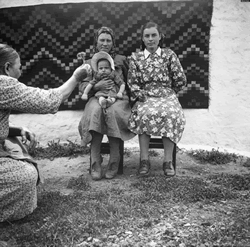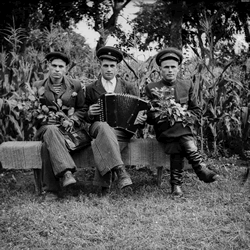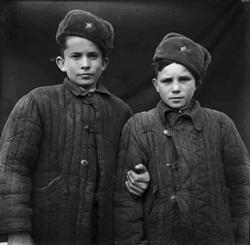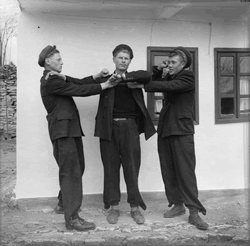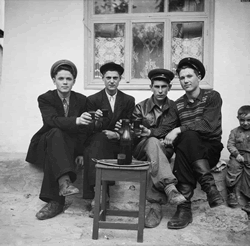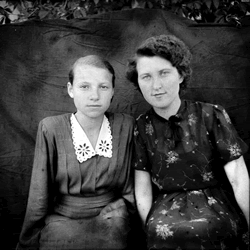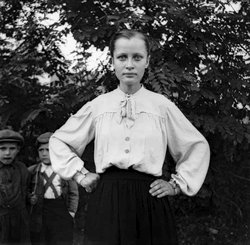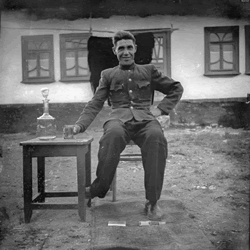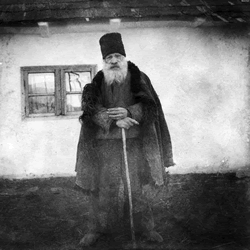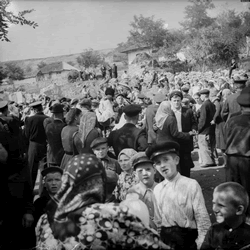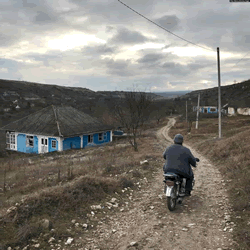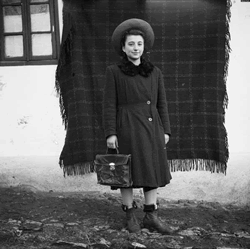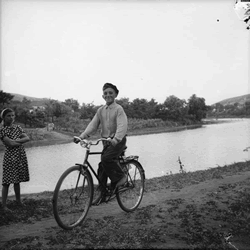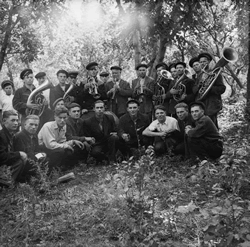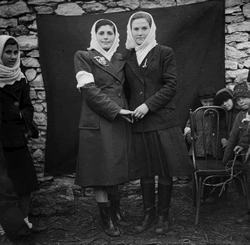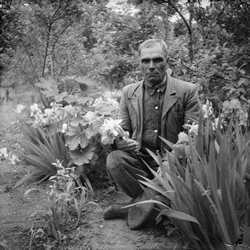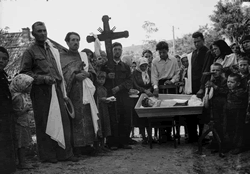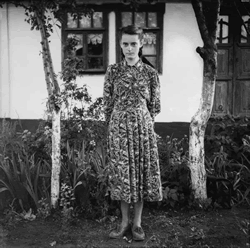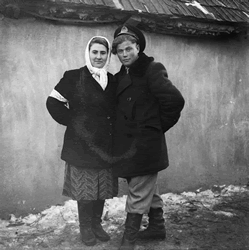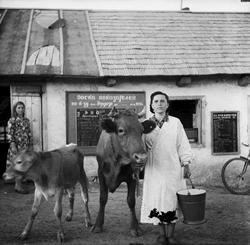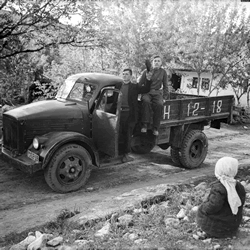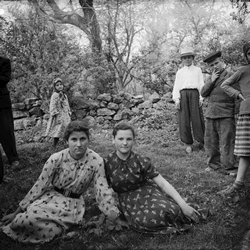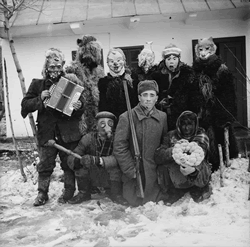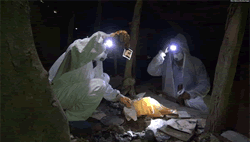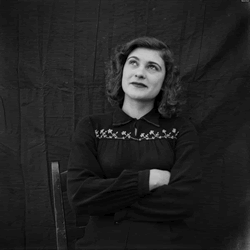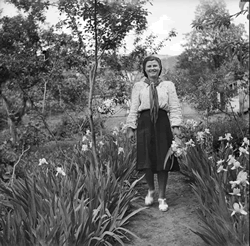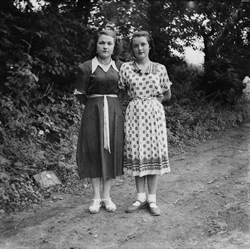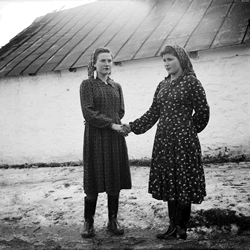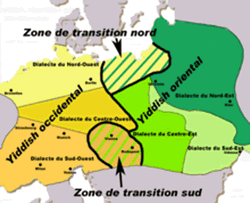Jewish Political Movements in the Early 20th Century
The General Jewish Labour Bund in Lithuania, Poland and Russia, Algemeyner Yidisher Arbeter Bund in Litah, Poyln un Rusland), generally called The Bund (Yiddish: ????, cognate to German: Bund, meaning federation or union) or the Jewish Labour Bund, was a secular Jewish socialist party in the Russian Empire, active between 1897 and 1920. In 1917 the Polish part of the Bund, which dated to the times when Poland was a Russian territory, seceded from the Russian Bund and created a new Polish General Labor Bund which continued to operate in Poland in the years between the two world wars. The Russian Bund was dissolved in 1920 and incorporated into the Communist Party. Other remnants of the Bund endured in various countries. A member of the Bund was called a Bundist.
Founding[edit]
The "General Jewish Labour Bund in Russia and Poland" was founded in Vilnius on October 7, 1897.[1] The name was inspired by the General German Workers' Association.[2] The Bund sought to unite all Jewish workers in the Russian Empire into a united socialist party, and also to ally itself with the wider Russian social democratic movement to achieve a democratic and socialist Russia. The Russian Empire then included Lithuania, Latvia, Belarus, Ukraine and most of present-day Poland, areas where the majority of the world's Jews then lived. They hoped to see the Jews achieve a legal minority status in Russia. Of all Jewish political parties of the time, the Bund was the most progressive regarding gender equality, with women making up more than one-third of all members.[3]
In 1901, the word 'Lithuania' was added to the name of the party.[2][4]
During the period of 1903–1904, the Bund was harshly affected by Czarist state repression. Between June 1903 and July 1904, 4,467 Bundists were arrested and jailed.[5]
As part of the Russian Social Democracy

Members of the Bund with the bodies of their comrades, murdered during the Odessa pogrom in 1905
Given the Bund's secular and socialist perspective, it opposed what it viewed as the reactionary nature of traditional Jewish life in Russia. Created before the Russian Social Democratic Labor Party (RSDLP), the Bund was a founding collective member at the RSDLP's first congress in Minsk in March 1898. For the next 5 years, the Bund was recognized as the sole representative of the Jewish workers in the RSDLP, although many Russian socialists of Jewish descent, especially outside of the Pale of Settlement, joined the RSDLP directly.
At the RSDLP's second congress in Brussels and London in August 1903, the Bund's autonomous position within the RSDLP was rejected under pressure by the Bolsheviks and the Bund's representatives left the Congress, the first of many splits in the Russian social democratic movement in the years to come.[6] The five representatives of the Bund at this Congress were Vladimir Kossowsky, Arkadi Kremer, Mikhail Liber, Vladimir Medem and Noah Portnoy.[7]
The Bund formally rejoined the RSDLP when all of its faction reunited at the Fourth (Unification) Congress in Stockholm in April 1906, with the support of the Mensheviks,[6] but the RSDLP remained fractured along ideological and ethnic lines. The Bund generally sided with the party's Menshevik faction led by Julius Martov and against the Bolshevik faction led by Vladimir Lenin during the factional struggles in the run-up to the Russian Revolution of 1917.[6]
5th Congress[edit]
The fifth congress of the Bund met in Zürich in June 1903. 30 delegates took part in the proceedings, representing the major city branches of the party and the Foreign Committee. Two issues dominated the debates; the upcoming congress of the RSDLP and the national question. During the debates there was a division between the older guard of the Foreign Committee (Kossovsky, Kremer and John (Yosef) Mill and the younger generation represented by Medem, Liber and Raphael Abramovitch. The younger group wanted to stress the Jewish national character of the party. In the end no compromise could be reached, and no resolution was adopted on the national question.[8]
1905 Revolution and its aftermath
In the Polish areas of the empire, the Bund was a leading force in the 1905 revolution. During the following years, the Bund went into a period of decay. The party tried to concentrate on labour activism around 1909–1910 and led strikes in ten cities. The strikes resulted in a deepened backlash for the party, and as of 1910 there were legal Bundist trade unions in only four cities, Bia?ystok, Vilnius, Riga and ?ód?. Total membership in Bundist unions was around 1,500. At the time of the eight party conference only nine local branches were represented (Riga, Vilnius, Bia?ystok, ?ód?, Bobruisk, Pinsk, Warsaw, Grodno and Dvinsk) with a combined membership of 609 (out of whom 404 were active).[9]
After the RSDLP finally split in 1912, the Bund became a federated part of the Russian Social Democratic Labour Party (Menshevik) (by this time the Mensheviks had accepted the idea of a federated party organization).[10]
Parliamentary representation[edit]
At the 1906 First Duma elections, the Bund made an electoral agreement with the Lithuanian Labourers' Party (Trudoviks), which resulted in the election to the Duma of two (apparently non-Bundist) candidates supported by the Bund: Dr. Shmaryahu Levin for the Vilnius province and Leon Bramson for the Kaunas province. In total, there were twelve Jewish deputies in the Duma, falling to three in the Second Duma (February 1907 to June 1907), two in the Third Duma (1907–1912) and again three in the fourth, elected in 1912, none of them being affiliated to the Bund.[11]
Political outlook[edit]
The Bund eventually came to strongly oppose Zionism,[12] arguing that emigration to Palestine was a form of escapism. The Bund did not advocate separatism. Instead, it focused on culture, rather than a state or a place, as the glue of Jewish "nationalism." In this they borrowed extensively from the Austro-Marxist school, further alienating the Bolsheviks and Lenin. The Bund also promoted the use of Yiddish as a Jewish national language and to some extent opposed the Zionist project of reviving Hebrew.[13][14]
The Bund won converts mainly among Jewish artisans and workers, but also among the growing Jewish intelligentsia. It led a trade union movement of its own. It joined with the Poalei Zion (Labour Zionists) and other groups to form self-defense organisations to protect Jewish communities against pogroms and government troops. During the Russian Revolution of 1905 the Bund headed the revolutionary movement in the Jewish towns, particularly in Belarus and Ukraine.
Activities abroad[
Less than a year after the founding of the party, its Foreign Committee was set up in Geneva. Also within the same timespan, Bundist groups began to constitute themselves internationally. However, the Bund did not construct any world party (as did Poalei Zion). On the contrary, the Bund argued that it was a party for action inside the Russian empire. The Bundist groups abroad were not included into the party structures. In 1902, a United Organization of Workers' Associations and Support Groups to the Bund Abroad was founded. The groups affiliated to the United Organization played an important role in raising funds for the party.[15]
Between 1901–1903, the Foreign Committee was based in London.[15]
The United Organization, the Foreign Committee as well as the Union of Russian Social Democrats Abroad were all dissolved at the time of the Russian revolution of 1917.[15]
Separation of the Polish Bund
When Poland fell under German occupation in 1914, contact between the Bundists in Poland and the party centre in St. Petersburg became difficult. In November 1914 the Bund Central Committee appointed a separate Committee of Bund Organizations in Poland to run the party in Poland.[16] Theoretically the Bundists in Poland and Russia were members of the same party, but in practice the Polish Bundists operated as a party of their own.[17] In December 1917 the split was formalized, as the Polish Bundists held a clandestine meeting in Lublin and reconstituted themselves as a separate political party.[18]
1917
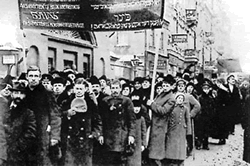
A Bundist demonstration, 1917
The Bund was the only Jewish party that worked within the soviets.[19] Like other socialist parties in Russia, the Bund welcomed the February Revolution of 1917, but it did not support the October Revolution in which the Bolsheviks seized power. Like Mensheviks and other non-Bolshevik parties, the Bund called for the convening of the Russian Constituent Assembly long demanded by all Social Democratic factions.[20] The Bund's key leader in Petrograd during these months was Mikhail Liber, who was to be roundly denounced by Lenin. With the Russian Civil War and the increase in anti-Semitic pogroms by nationalists and Whites, the Bund was obliged to recognise the Soviet government and its militants fought in the Red Army in large numbers.
At the time of the 1917 upheavals, Mikhail Liber was elected president of the Bund.[21] In May 1917, a new Central Committee of the Bund was formed, consisting of Goldman, Erlich, Medem and Jeremiah Weinsthein. One Central Committee member, Medem, was in Poland at the time and couldn't travel to Saint Petersburg to meet with the rest of the Committee.[22]
Four Bund bureaus were represented as such among the 60 delegates to the May 1918 Menshevik Party conference: Moscow (Abramovich), Northern (Erlich), Western (Goldshtein, Melamed) and Occupied Lands (Aizenshtadt).[23]
The political changes at the time of the Russian revolution resulted in splits in the Bund. In Ukraine, Bund branches in cities like Bobruisk,[clarification needed]Ekaterinoburg[clarification needed] and Odessa had formed 'leftwing Bund groups' in late 1918. In February 1919 these groups (representing the majority in the Bund in Ukraine) adopted the name Communist Bund (Kombund), re-constituting themselves as an independent party. Moisei Rafes, who had been a leading figure of the Bund in Ukraine, became the leader of the Ukrainian Kombund.[24][25][26] The Communist Bund supported the Soviet side in the Russian Civil War.[27][28] Other members of the Bund (representing the minority in the Bund in Ukraine) at the end of 1918 formed the Social Democratic Bund (Bund SD). Leaders of the Ukrainian Social Democratic Bund - Sore Fox, A. Litvak, David Petrovsky(Lipets) openly opposed the communist ideology and policy of confiscation of property, usurpation of political power, arrests and persecution of political opponents.[29]
The Bund also had elected officials at the local level. During the 1917 October Revolution and Russian Civil War, the mayor of the predominantly Jewish Ukrainian town of Berdychiv(53,728 inhabitants, 80% of whom were Jewish at the 1897 census) was a Bundist, David Petrovsky (Lipets).[30]
Final split at the Gomel conference[edit]
The remainder Bund in Russia held a conference (the Twelfth Conference of the Bund) on April 12–19, 1920 in Gomel, where the party was split into two separate parties, the majority Communist Bund (Kombund) and the minority Social Democratic Bund.[31][32]
The fourteen point of the resolution "On the Present Situation and the Tasks of Our Party" stated that
Summing up the experience of the last year, the Twelfth Conference of the Bund finds:
1 that the Bund, in principle, had adopted the communist platform since the Eleventh Conference,
2 that the Programme of the Communist Party, which is also the programme of the Soviet government, corresponds with the fundamental platform of the Bund,
3 that a ’united socialist front’ with principled opponents of Soviet power, who draw a line between the proletariat and its government, is impossible,
4 that the moment has come when the Bund can relinquish its official oppositional stand and take upon itself responsibility for the Soviet government’s policy.[33]
The resolution on organisational questions stated that
The logical consequence of the political stand adopted by the Bund is the latter’s entry into the R.C.P on the same basis as the Bund’s membership of the R.S.D.L.P.. The conference authorised the C.C. of the Bund to see to it, as an essential condition, that the Bund preserve within the R.C.P. the status of an autonomous organisation of the Jewish proletariat.[33]
Legacy[edit]
In 1921, the Communist Bund dissolved itself and its members sought admission to the Communist Party.[33] As of 1923, the last Bundist groups had ceased to function in Soviet Russia.[32] Many former Bundists, like Mikhail Liber and David Petrovsky, perished during Stalin's purges in the 1930s. The Polish Bundists continued their activities until 1948. During the latter half of the 20th century the Bundist legacy was represented through the International Jewish Labor Bund, a federation of local Bundist groups around the world.
Former Bundists who became high level officials in the USSR[edit]
? Israel Moiseevich Leplevsky (1894–1938), Bundist in 1904–1907, Minister ("People's Commissar") of Internal Affairs of the Ukrainian Soviet Socialist Republic (1937–1938)
? Moisei Leibovits Ruhymovych (1889–1939), Bundist in 1904–1913, Minister ("People's Commissar") for military affairs of the Donetsk-Krivoy Rog Soviet Republic (1917–1918) and Minister ("People's Commissar") for Defense Industry of the USSR (1936–1937)
? David Petrovsky (1886-1937), Bundist in 1902–1919, a Chief of the General Directorate of military educational institutions (GUVUZ) [34] of the Red Army (1920-1924), a member of the Presidium of the Executive Committee of the Communist International (1924-1929), a member of the Presidium to the Supreme Soviet of the National Economy (1929-1932), a Chief of the Department of higher and secondary technical educational institutions (GLAVVTUZ) in the Ministry (People's Commissariat) of Soviet Heavy Industry (1932-1937).
The Bundists in North America[edit]
See also: International Jewish Labor Bund
Among the exiled Bundists who went on with Socialist politics in America was Baruch Charney Vladeck (1886–1938), elected to the New York Board of Aldermen as a Socialist in 1917, defeated in 1921 but re-elected in 1937 to the newly formed New York City Council running on the American Labor Party ticket. He was also the manager of The Jewish Daily Forward from 1918 till his death.[35]
Moishe Lewis (1888–1950) was a Bundist leader in his Polish (now Belarusian) hometown Svislosz before he emigrated to Canada in 1922.[36] He was the father of David Lewis(1909–1981), a leader of the New Democratic Party in Canada.
The American Labour leader David Dubinsky (1892–1982), though never formally a member of the party, had joined the bakers' union, which was controlled by the Bund, and was elected assistant secretary within the union by 1906. He made his way to the United States in 1911. He later became a member of the Socialist Party of America, helped found the American Labor Party in 1936 and was from 1932 till 1966 the leader of the International Ladies' Garment Workers' Union.[37]
Between 1913 and 1917, working under the name Max Goldfarb, David Petrovsky (1886–1937) was a member of the Central Committee of the Jewish Socialist Federation of America, a member of the Socialist Party of America, and the editor of The Forward.
Footnotes[edit]
1 ^ Hirsz Abramowicz; Eva Zeitlin Dobkin; Dina Abramowicz; Jeffrey Shandler; David E. Fishman (1999). Profiles of a Lost World: Memoirs of East European Jewish Life Before World War II. Wayne State University Press. p. 14. ISBN 978-0-8143-2784-5.
2 ^ Jump up to:a b Minczeles, Henri. Histoire générale du Bund: un mouvement révolutionnaire juif. Paris: Editions Austral, 1995. p. 61
3 ^ Shepherd, Naomi (1994). A price below rubies: Jewish women as rebels and radicals. Harvard University Press. p. 139. ISBN 978-0-674-70411-4.
4 ^ Zimmerman, Joshua D. (2004). Poles, Jews, and the Politics of Nationality. University of Wisconsin Press. p. 123.
5 ^ Minczeles, Henri. Histoire générale du Bund: un mouvement révolutionnaire juif. Paris: Editions Austral, 1995. p. 119
6 ^ Jump up to:a b c Angel Smith; Stefan Berger (1999). Nationalism, Labour and Ethnicity: 1870–1939. Manchester University Press. p. 150. ISBN 978-0-7190-5052-7.
7 ^ Vital, David (2001). A people apart: a political history of the Jews in Europe, 1789–1939. Oxford University Press. p. 944. ISBN 978-0-19-924681-6. Retrieved 2009-11-05.
8 ^ Minczeles, Henri. Histoire générale du Bund: un mouvement révolutionnaire juif. Paris: Editions Austral, 1995. p. 130
9 ^ Johnpoll, Bernard K. The Politics of Futility; The General Jewish Workers Bund of Poland, 1917–1943. Ithaca, N.Y.: Cornell University Press, 1967. pp. 33–34
10 ^ Johnpoll, Bernard K. The Politics of Futility; The General Jewish Workers Bund of Poland, 1917–1943. Ithaca, N.Y.: Cornell University Press, 1967. p. 35
11 ^ Levin, Dov (2000). The Litvaks: a short history of the Jews in Lithuania. Berghahn Books. p. 283. ISBN 978-1-57181-264-3. Retrieved 2009-11-07.
12 ^ Walter Laqueur (2003). The History of Zionism. TaurisParke Paperbacks. p. 273. ISBN 978-1-86064-932-5.
13 ^ David E. Fishman (2005). The Rise of Modern Yiddish Culture. University of Pittsburgh Press. p. 49. ISBN 978-0-8229-4272-6.
14 ^ Schreiber, Mordecai; Schiff, Alvin I.; Klenicki, Leon (2003). The Shengold Jewish Encyclopedia. Schreiber Pub. p. 56. ISBN 978-1-887563-77-2.
15 Jacobs, Jack Lester. Jewish Politics in Eastern Europe: The Bund at 100. Basingstoke: Palgrave, 2001. pp. 46–51
16 ^ Johnpoll, Bernard K. The Politics of Futility; The General Jewish Workers Bund of Poland, 1917–1943. Ithaca, N.Y.: Cornell University Press, 1967. p. 37
17 ^ Johnpoll, Bernard K. The Politics of Futility; The General Jewish Workers Bund of Poland, 1917–1943. Ithaca, N.Y.: Cornell University Press, 1967. pp. 52–53, 61
18 ^ Johnpoll, Bernard K. The Politics of Futility; The General Jewish Workers Bund of Poland, 1917–1943. Ithaca, N.Y.: Cornell University Press, 1967. pp. 69–70
19 ^ Johnpoll, Bernard K. The Politics of Futility; The General Jewish Workers Bund of Poland, 1917–1943. Ithaca, N.Y.: Cornell University Press, 1967. p. 56
20 ^ Robert Paul Browder; Alexander F Kerensky (1961). The Russian Provisional Government, 1917: Documents. Stanford University Press. p. 428. ISBN 978-0-8047-0023-8.
21 ^ Johnpoll, Bernard K. The Politics of Futility; The General Jewish Workers Bund of Poland, 1917–1943. Ithaca, N.Y.: Cornell University Press, 1967. p. 59
22 ^ Johnpoll, Bernard K. The Politics of Futility; The General Jewish Workers Bund of Poland, 1917–1943. Ithaca, N.Y.: Cornell University Press, 1967. p. 61
23 ^ Brovkin, Vladimir. N. (1991). The Mensheviks after October: socialist opposition and the rise of the Bolshevik dictatorship. Ithaca: Cornell University Press. pp. 201–204. ISBN 978-0-8014-9976-0. Retrieved 2009-11-10.
24 ^ Nora Levin (1991-01-01). Jews in the Soviet Union Since 1917: Paradox of Survival. NYU Press. p. 61. ISBN 978-0-8147-5051-3.
25 ^ Abraham Malamat; Haim H Ben-Sasson (1976). A History of the Jewish People. Harvard University Press. p. 966. ISBN 978-0-674-39731-6.
26 ^ Benjamin Pinkus (1990-01-26). The Jews of the Soviet Union: The History of a National Minority. Cambridge University Press. p. 128. ISBN 978-0-521-38926-6.
27 ^ Elizabeth A. Wood (2005). Performing Justice: Agitation Trials In Early Soviet Russia. Cornell University Press. p. 261. ISBN 978-0-8014-4257-5.
28 ^ Haim Hillel Ben-Sasson (March 2007). Geschichte des jüdischen Volkes: Von den Anfängen bis zur Gegenwart. C.H.Beck. p. 1186. ISBN 978-3-406-55918-1.
29 ^ Joshua Meyers, “A Portrait of Transition: From the Bund to Bolshevism in the Russian Revolution,” Jewish Social Studies: History, Culture, Society n.s. 24, no. 2 (Winter 2019): 107–134. Copyright © 2019 The Trustees of Indiana University. doi: 10.2979/jewisocistud.24.2.09
30 ^ Ettinger, Shmuel; Shmuel Spector (2008). "Berdichev". Encyclopaedia Judaica. Retrieved 6 December 2009.
31 ^ Michael Brenner; Derek J. Penslar (1998). In Search of Jewish Community: Jewish Identities in Germany and Austria, 1918–1933. Indiana University Press. p. 127. ISBN 978-0-253-21224-5.
32 ^ Jump up to:a b Fruma Mohrer; Marek Web, eds. (1998). Guide to the Yivo Archives. Yivo Institute for Jewish Research/M.E. Sharpe. p. 43. ISBN 978-0-7656-0130-8.
33 ^ Jump up to:a b c explanatory note to Lenin, Vladimir I. (April 19 – May 6, 1920). "To Members of the Politbureau of the C.C., R.C.P.(B.)". Marxists Internet Archive. Lenin Internet Archive (2003). Retrieved 2009-11-10., from documents archived at the Central Party Archives, Institute of Marxism-Leninism of the C.C., C.P.S.TJ.
34 ^ The General Directorate of military educational institutions: Ministry of Defence of the Russian Federation - Encyclopediahttp://encyclopedia.mil.ru/encyclopedia/dictionary/details_rvsn.htm?id=5376@morfDictionary
35 ^ Gitelman, Zvi Y. (2003). The Emergence of Modern Jewish Politics: Bundism and Zionism in Eastern Europe. University of Pittsburgh Press. p. 184. ISBN 978-0-8229-4188-0. Retrieved 2009-12-04.
36 ^ Fuerstenberg, Adam. "The Marvellous Trajectory of David Lewis' Life and Career". Toronto: Beth Tzedec Congregation. Archived from the original on 19 July 2011. Retrieved 25 November 2009.
37 ^ Robert D. Parmet (2005-07-30). The Master Of Seventh Avenue: David Dubinsky And The American Labor Movement. NYU Press. p. 7. ISBN 978-0-8147-6711-5.
38 Further reading[edit]
• Jack Jacobs (ed.), Jewish Politics in Eastern Europe: The Bund at 100. New York: New York University Press, 2001.
• Alfred Katz, "Bund: The Jewish Socialist Labor Party," The Polish Review, vol. 10, no. 3 (Summer 1965), pp. 67–74.
• Molly Crabapple, "My Great-Grandfather the Bundist," New York Review of Books, 6 Oct. 2018. [1]
39
The pictures are found here;
http://yivo1000towns.cjh.org/search_results.asp?city_town=&country_id=0&KW_001=bund&KW_002=&KW_003=&KW_101=&KW_102=&KW_103=&start_year=&end_year=&photographer=&SearchType=Compound&Action=Search |
The Bund |
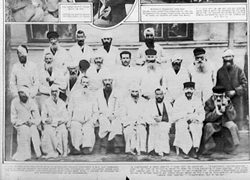 |
#B-001
1905
Siedlce
"Wounded Jews. This photo of "young revolutionaries" the commander of a Tsarist regiment claimed he had attacked (inside a synagogue after a May Day demonstration by the Bund [Jewish Socialist Labor Party]) was sent to Minister Stolypin with a protest." ('Jewish Daily Forward') |
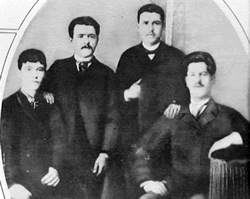 |
#B-002
890's
Siauliai
Formal portrait of a Jewish Socialist Bund group: (l-r) David Moffs ("now in Pretoria, South Africa"), Morris Vinocur (Weiner, "now in Chicago"), "Orke" Kessler, Bernard Feldman (now "Forward" representative in Springfield, Ma.) ('Forward' spread, 1937). |
 |
#B-003
1905
Vileyka
Polish and Russian Social Democrats and members of the Jewish Socialist Bund pose with banners and wreaths during an outdoor demonstration to honor the victims of the October 1905 pogrom. |
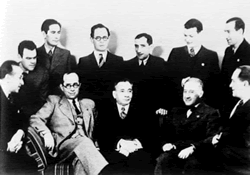 |
#B-004
1930's
Cracow
Portrait of Dr. Leon Feiner, Dr. Salo Fiszgrund, Dr. Henryk Schreiber, Bursztyn, Herman Berger, Kuther, Wolfgang, Moyshe Pelcman-Glazer, Kupfer, and other activists of the Jewish Socialist Bund. |
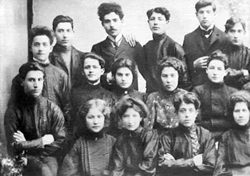 |
#B-005
1905
Grodno
Studio portrait of young men and woman, members of the [Jewish Socialist] Bund. (Part of a photo essay in the 'Jewish Daily Forward', 1929: "Jewish Revolutionaries Of The Past.") |
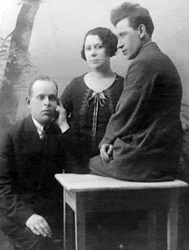 |
#B-006
1920's
Gabin
Studio portrait of (right to left) Henokh Goldschmidt, his wife Rokhl Preyzinger Goldschmidt and their friend Shloyme Adler. Goldscmidt, from a Hasidic background, became active in revolutionary movements. He was a leader of the Jewish Socialist Bund. |
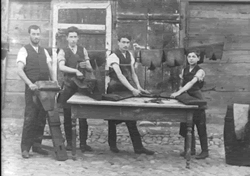 |
#B-007
1909
Gabin
Four young leather workers outdoors: (r to l) an apprentice, Yekel Tiber, Henokh Goldschmidt (who had just left the yeshiva) and a young worker from Kutno. Goldschmidt, from a Hasidic background, later became a leader of the Jewish Socialist Bund. |
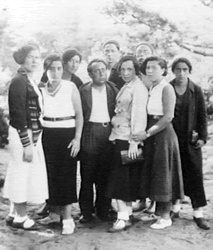 |
#B-008
ca. 1920s
Gdynia
Outdoor portrait of members of Tsukunft (Jewish Socialist Bund youth group): (4th from left) Sergej Nutkiewicz. |
 |
#B-009
1938
Grabow
Outdoor portrait of members of Tsukunft, the youth movement of the Jewish Socialist Bund. |
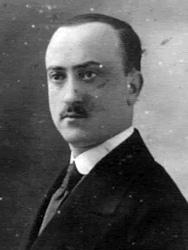 |
#B-010
Kalisch
Studio portrait of Yudi Perle, a Tsarist agent-provocateur, member of the local committee of the Jewish Socialist Bund during 1903-1905. |
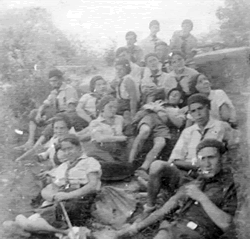 |
#B-011
1933
Kazimierz
Members of Tsukunft (the youth movement of the Jewish Socialist Bund) posing in uniform, at their first summer camp. |
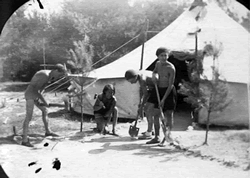 |
#B-012
1933
Kazimierz
Young people working outdoors by a tent, at the first summer camp of Tsukunft (the youth movement of the Jewish Socialist Bund). |
 |
#B-013
1936
Kazimierz
Members of Tsukunft (the youth movement of the Jewish Socialist Bund) posing by a horse-drawn wagon of hay at a summer camp. |
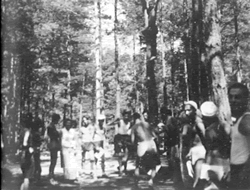 |
#B-014
1936
Kazimierz
Members of Tsukunft (the youth movement of the Jewish Socialist Bund) posing in a clearing in the woods while attending summer camp. |
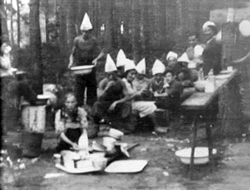 |
#B-015
1936
Kazimierz
"Hygiene Day" at a summer camp run by Tsukunft (the youth movement of the Jewish Socialist Bund): men and women wearing white paper hats in the woods. |
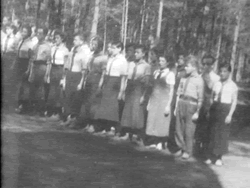 |
#B-016
1936-37
Kazimierz
"Line-up": young men and women stand at attention at a summer camp run by Tsukunft (the youth movement of the Jewish Socialist Bund). |
 |
#B-017
1936
Kazimierz
At the castle of Kazimierz the Great: members of a Tsukunft (youth movement of the Jewish Socialist Bund) summer camp on a hike. |
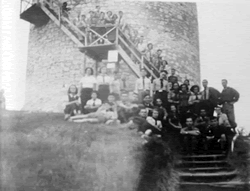 |
#B-018
1936
Kazimierz
On a hike to the castle of Kazimierz the Great: members of a Tsukunft (youth movement of the Jewish Socialist Bund) summer camp posing in front of the bastille. |
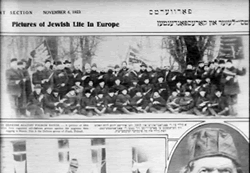 |
#B-019
1905
Pinsk
Formal portrait in the snow of the Bund Fighting Organization . ('Jewish Daily Forward' caption in Yiddish:) "...When Jewish youth armed themselves to defend themselves against the bands perpetrating pogroms..." |
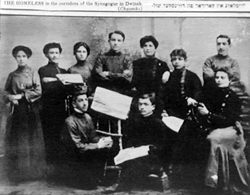 |
#B-020
1906
Radziwillow
Studio portrait of the Jewish Socialist Bund organization of the city. |
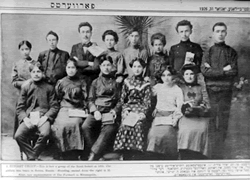 |
#B-021
1905
Rovno
"Bundists of 20 years ago. Interesting Russian-Jewish types of the [Jewish Socialist] Bund... Second from right [standing] is D. Shier, our 'Forward' representative in Minneapolis." ("Jewish Daily Forward" Yiddish caption.) |
 |
#B-022
pub. Nov. 21, 1926
Warsaw
photo by: Kacyzne, Alter
"A cooperative workshop of the [Jewish Socialist Labor] Bund" ('Jewish Daily Forward' caption). |
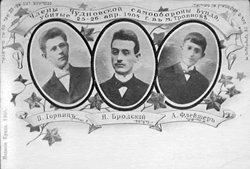 |
#B-023
ca. 1905
Chudnov
Vignetted portraits of three young men, "members of the [Jewish Socialist] Bund's self-defense organization killed April 23-26, 1905 in Chudnov" (printed in Russian and Yiddish). (Left to right) P. Gorvits, Y. Brodski, and A. Fleysher. (A postcard.) |
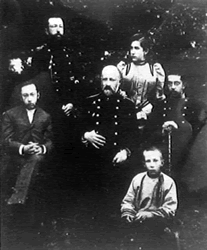 |
#B-024
Minsk
Formal outdoor family portrait: (Yiddish caption) "Dr. Dovid Medem, G. [Gina]Medem's father, and his children: the child in the blouse [lower r] is the little Vladimir Medem [later a Bund leader]." Three men wear uniforms; woman in puffed sleeves stands (r). |
 |
#B-025
1905
Minsk
Portrait of members of the Jewish Socialist Bund wounded in the October pogrom: young men and women, some bandaged or wearing slings. |
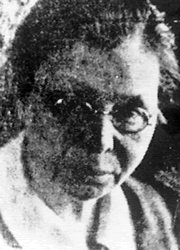 |
#B-026
Minsk
Portrait of Zhenia Horowitz, a prominent member of the Jewish Socialist Bund. |
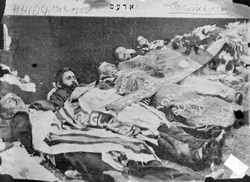 |
#B-027
ca. 1905
Odessa
After a pogrom: the corpses of murdered victims, members of the Jewish Socialist Bund, draped in banners. (Included in a photo spread: "Odessa: The Murdered Members Of The Self-Defense," in the Petrograd Yiddish newspaper "Der Fraynd" [The Friend].) |
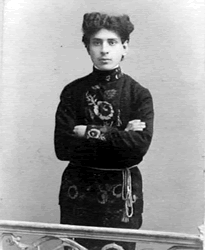 |
#B-028
ca. 1900
Odessa
photo by: Mulman, K.
Vignetted studio portrait of Yankl, a young man wearing an embroidered Russian blouse, standing, with arms crossed: (written on back in Yiddish) "Yankl, one of the founders of the Bund together with me, B. Litman, Toronto, Canada." |
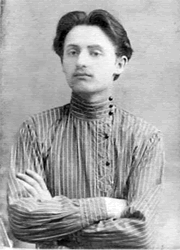 |
#B-029
Odessa
Studio portrait of Greynim, a young man (with arms crossed, in a striped Russian blouse): (written on back in Yiddish) "Greynim, one of the first ten members of the Bund, together with me, B. Litman, Toronto." |
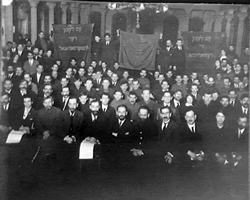 |
#B-030
Dec. 8-17, 1917
St. Petersburg
Portrait of participants (men and women) to the 8th conference of the [Jewish Socialist] Bund. Bund leaders sit in the front row: (r-l from the 3rd person) M. Litvak, M. Rafes, Liber, Rakhmiel Vaynshteyn, Raphael Abramovitch, Henryk Erlich (of Warsaw). |
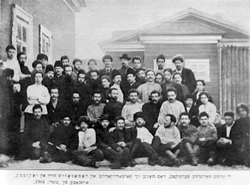 |
#B-031
1904
Yakutsk
Outdoor portrait of "the group of political exiles who barricaded themselves in Romanov's house" (Yiddish caption): men (some in fur hats) and women near wooden buildings. (A photograph published by the Jewish Socialist Bund.) |
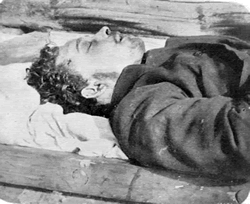 |
#B-032
1904
Yakutsk
Outdoor portrait of Yuri Matlakhov, a Social Democrat killed on March 4: a young man in winter clothes in the snow. (A photograph published by the Jewish Socialist Bund.) |
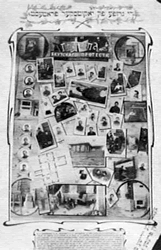 |
#B-033
1904
Yakutsk
Montage of (numbered) photographs and illustrations relating to the Yakutsk Protest Group (published by the Jewish Socialist Bund): (no.37) the Romanov house where protesters were barricaded; (no. 18) "The dog -- the letter-carrier" (Yiddish captions). |
 |
#B-034
pub. 1905
Zhitomir
Studio portrait of Leybe Vaynshteyn, a member of the Jewish Socialist Bund, killed on April 24, 1905 during a pogrom as he took part in its self-defense activities. (A postcard published by the Bund.) |
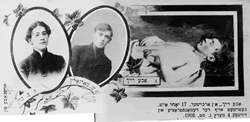 |
#B-035
Before 1905
Warsaw
Vignetted studio portraits of (left) E. Cohen and (right) twenty-two-year-old Shloyme Margolin, both killed during a demonstration in April 1905. (From a photo spread on a postcard printed by the Jewish Socialist Bund.) |
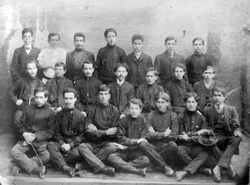 |
#B-036
ca. 1906
Kaunas
Studio portrait of young men, members of a Jewish Socialist Bund self-defense group: (accompanying Yiddish letter by N. Levine) "Beynush Korber [now known as Benny Garber] is sitting in the bottom row, with the littlewhiskers." |
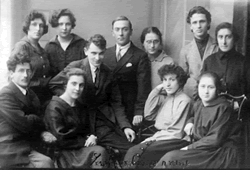 |
#B-037
Oct. 15, 1923
Telsiai
Group portrait of members of the Jewish Socialist Bund: young men and women. ( Standing, third from right, with a pince-nez) Sheve Raivits, a teacher at the Jewish 'folkshul' (elementary school). |
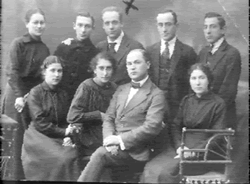 |
#B-038
ca. 1923
Telsiai
Studio portrait of Jewish Socialist Bund members: (standing, center) Nisn Pups, "a well-known Bundist leader in Vilna and in Lithuania... Came to a violent end in the 'Red Garden of Eden' [the Soviet Union]..." (1st and 2nd from l) Raivits and Yafe. |
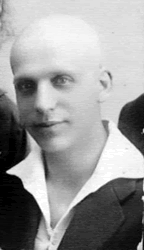 |
#B-039
Telsiai
Portrait of Nisn Pups, a leader of the Bund in Vilna and Lithuania who later met a violent death in the Soviet Union. |
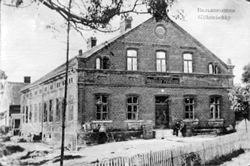 |
#B-040
Turn of the century
Vilkaviskis
The boy's secondary school: (on back in Yiddish) "This is the building where the soldiers used to muster, and also where big meetings of the brushmakers would take place, as well as discussions between the Jewish Socialist Bund and Poalei Zion members." |
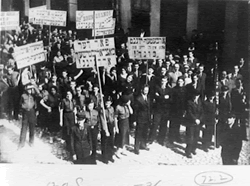 |
#B-041
ca. 1930
Riga
Participants in a Jewish Socialist Bund demonstration pose on a street. (Yiddish signs, l to r) "Adults -- Work, Children -- Bread!..."; "Against Militarization!"; "For the Socialist Order!"; "Working Youth. All in the ranks of the Bund!" |
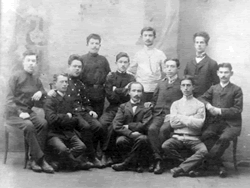 |
#B-042
1904
Pinsk
Studio portrait of Jewish Socialist Bund members, two of whom (Joe Kaplan and Charlie Siegel) later emigrated to the USA. |
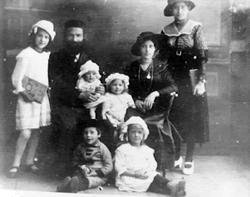 |
#B-043
Tomaszew
The Bund family with their many children. |
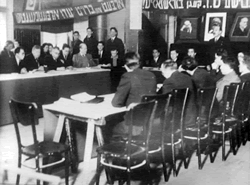 |
#B-044
January 27-28, 1934
Latvia
At a Jewish Socialist Bund conference: a man (standing, r) addresses participants. (Yiddish banners) "Work and bread for every worker" and "Latvian S.D. [Social Democrats] against the bourgeoisie!" (Portraits, 2nd and 3rd from r) Vladimir Medem and Karl Marx. |
 |
#B-045
1937
Iwanicz Zdroj
Abraham Penzik (right) and his daughter Irena (left). With them are a Jewish industrialist and two members of the Jewish Socialist Bund. |
 |
#B-046
1930
Miedzyrzec
Studio portrait of the city council: (l to r) Shloyme Kamien (a Folkist); Bentsien Sheynmel (a Folkist); the mayor of Korbak (a non-Jew); Berl Vernitsky (B. Warren), a member of the Jewish Socialist Bund; and Gursky (a non-Jew), a deputy of the Sejm. |
 |
#B-047
1933
Pinsk
Outdoor portrait of young members of the Jewish Socialist Bund's Morgnshtern sports club: (seated, left to right, in dark suits) Bund board members L. Kaplan, Y. Urbaytl and Sh. Mandlboym; (seated between them) instructor T.L. Fraynd. |
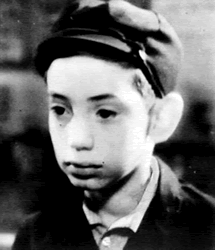 |
#B-048
1936
Miedzeszyn
photo by: Vishniac, Roman
Portrait of a young boy - an actor from the Jewish Socialist Bund's "Mir kumen on" (We Are Coming), a film about the Medem Sanatorium. |
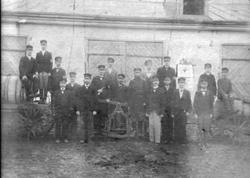 |
#B-049
ca. 1900
Chudnov
Portrait of members of the fire brigade (est. 1891), with pump and water-wagons: (4th from r, marked with arrow) Khayem Taffel. (Written in Yiddish) "Among them are participants in the [Jewish Socialist] Bund's self-defense group killed [in 1905]." |
 |
#B-050
1905
Odessa
Group portrait of a Bund self-defense group at the cemetery with the banner-draped corpses of three of their leaders, Visotski, Sheltipsi and Yekhiel. |
 |
#B-051
ca. 1935
Miedzeszyn
A line of children on a hillside at the Jewish Socialist Bund 's Medem Sanatorium. (Yiddish headline) "On the tenth anniversary of the Medem Sanatorium." |
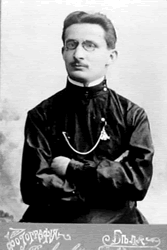 |
#B-052
ca. 1900
Miedzyrzec
photo by: Rafael
Studio portrait of `Avrom der blinder' (Avrom the Blind), a Jewish Socialist Bund organizer of workers in the brush manufacturing industry. |
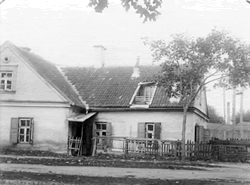 |
#B-053
1920s-30s
Vilna
photo by: Grossman, Moryc
The house in which the Jewish Socialist Bund was founded in 1897. |
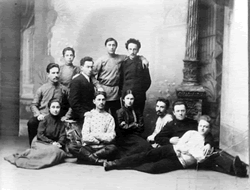 |
#B-054
Before World War I
Pinsk
Studio portrait of young members of the Jewish Socialist Bund. |
 |
#B-055
Lipno
Portrait of members of the Bund. |
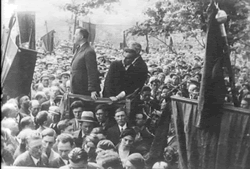 |
#B-056
1936
Lodz
Speakers address crowds at the funeral of Yisroel Lichtenstein, leader of the Jewish Socialist Bund. |
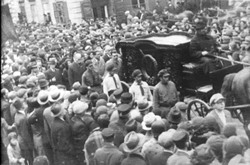 |
#B-057
1936
Lodz
Crowds watch the funeral procession of Yisroel Lichtenstein, leader of the Jewish Socialist Bund. |
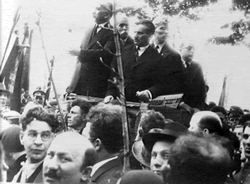 |
#B-058
1936
Lodz
Notables at the funeral of Yisroel Lichtenstein, leader of the Jewish Socialist Bund. |
 |
#B-059
1914
Lodz
Studio portrait of Khaim Zylbermintz, a member of the Jewish Socialist Bund. |
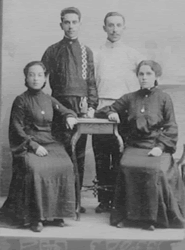 |
#B-060
1908
Lodz
Studio portrait of four young people, members of the Jewish Socialist Bund. |
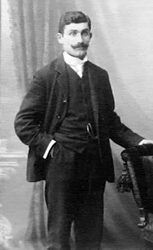 |
#B-061
Before World War I
Lodz
Studio portrait of Hersh Leyb Brenman, an activist in the Jewish Socialist Bund. |
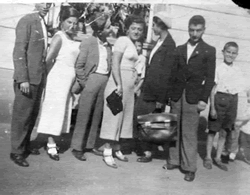 |
#B-062
1930's
Lodz
Members of Tsukunft (the youth movement of the Jewish Socialist Bund) standing in a courtyard at Przejarz No.9. |
 |
#B-063
1930s
Lubartow
Members of Tsukunft (the youth movement of the Jewish Socialist Bund) in uniform at a ceremony around a flagpole. |
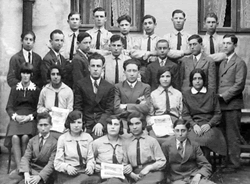 |
#B-064
1931
Lublin
Portrait of the Kalmen Kamashnmakher Chapter of the Tsukunft (the youth movement of the Jewish Socialist Bund), in uniform and holding copies of the Tsukunft publication, "Youth-Waker." |
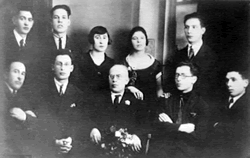 |
#B-065 |
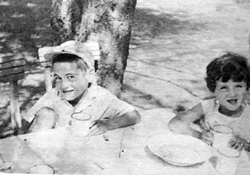 |
#B-066
1925-39
Miedzeszyn
Shmulik Minawsky, from Przytyk and another child, at an outdoor meal at the Jewish Socialist Bund's Medem Sanatorium. |
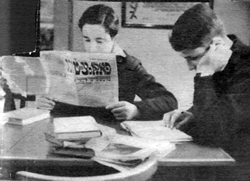 |
#B-067
1936
Minsk Mazowiecki
In a reading room at the Jewish Socialist Bund's Medem Sanatorium: two boys, one of whom reads the Yiddish newspaper, "Folkstsaytung." |
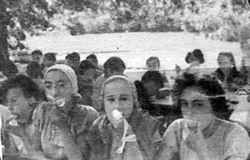 |
#B-068
1925-39
Miedzeszyn
Three girls at an outdoor meal at the Jewish Socialist Bund's Medem Sanatorium. |
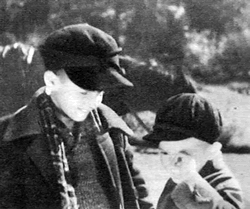 |
#B-069
ca. 1936
Miedzeszyn
Two boys at the Jewish Socialist Bund's Medem Sanatorium: (Yiddish caption) "They don't want to go home." |
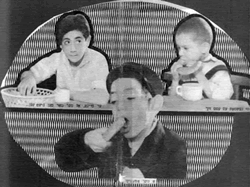 |
#B-070
1936
Miedzeszyn
Scenes from "Mir Kumen On," Alexander Ford's 1936 film about the Jewish Socialist Bund's Medem Sanatorium: children eating. (Yiddish captions, clockwise from top) "He thinks it's forbidden to eat seconds," "How tasty it is," "Bon Appetit!" |
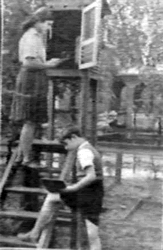 |
#B-071
ca. 1935
Miedzeszyn
Two children at a dovecote at the Jewish Socialist Bund's Medem Sanatorium. |
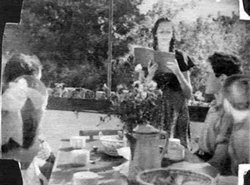 |
#B-072
1936
Miedzeszyn
Scene from "Mir Kumen On" (We Are On The Way), Alexander Ford's 1936 film about the Jewish Socialist Bund's Medem Sanatorium: a girl reads the "news of the day" at breakfast. (Yiddish caption) "They give you a lot of food there, five times a day..." |
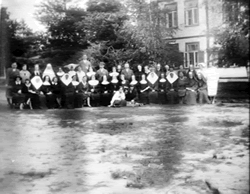 |
#B-073
1925-39
Miedzeszyn
Nuns pose for an outdoor portrait on a visit to the Jewish Socialist Bund's Medem Sanatorium. |
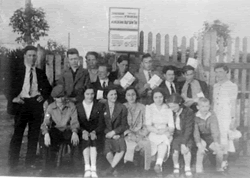 |
#B-074
1938
Miedzeszyn
While on a trip to the Jewish Socialist Bund's Medem Sanatorium: Jewish youth from Otwock pose for a groupportrait in front of a picket fence. |
 |
#B-075
1930's
Miedzyrzec
(Left to right) Rokhl Elncwajg, Feyge Goldfarb, Toyvye Czarny, and Moyshe Erdfarb, members of Tsukunft (the youth movement of the Jewish Socialist Bund), in a small boat. |
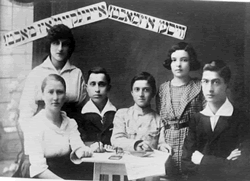 |
#B-076
1930s
Miedzyrzec
Studio portrait of young activists of Tsukunft (the youth movement of the Jewish Socialist Bund): Feyge Goldfarb, Toyvye Czarny, Rokhl Elncwajg, Moyshe Erdfarb, and others. The banners read (in Yiddish): "Knowledge Is Power! Unity Is Power!" |
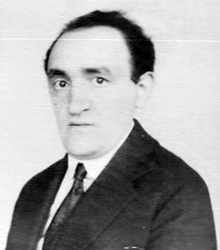 |
#B-077
1920s-30s
Mlawa
Studio portrait of Yisroel Alter, brother of Victor Alter, a leader of the Jewish Socialist Bund. |
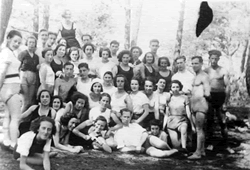 |
#B-078
1934
Mloczyn
Members of Tsukunft (the youth movement of the Jewish Socialist Bund) and Morgenshtern from Mlawa, posing during an outing. |
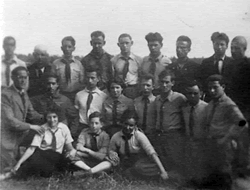 |
#B-079
1935
Novoyelnya
Men and women posing in uniform at the Y. Chmurner camp duirng the regional conference of the youth movement of Tsukunft, the youth movement of the Jewish Socialist Bund. |
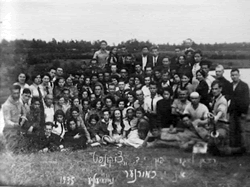 |
#B-080
1935
Novoyelnya
Members of Tsukunft, the youth movement of the Jewish Socialist Bund, pose at the Y. Chmurner camp during a regional conference. |
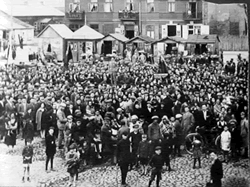 |
#B-081
1920s-30s
Nowy Dwor
Khayem Rudawski, leader of the local Jewish Socialist Bund, speaking to a crowd at a May Day demonstration in the marketplace. The banner (right of center) reads in Polish and Yiddish, "Down With Militarism." |
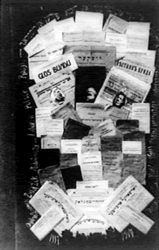 |
#B-082
1936
Pinsk
At an exhibition at the Jewish Trade School for Girls: a montage of photographs (Karl Marx at center) and publications in Yiddish, Russian and Polish from the first seven years of the Jewish Labor Bund in Lithuania, Poland and Russia (founded in 1897). |
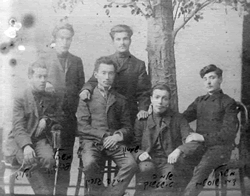 |
#B-083
1906
Pinsk
Bund activists: (sitting r-l) Moyshe Adler, shoemaker; Shloyme Zeleznikow, leader of a self-defense group; Yankev Gurin, one of the first political prisoners from Pinsk; Zelig, died fighting Petlyura's forces; (standing) Shimen and Moyshe Furman. |
 |
#B-084
1905
Pinsk
Portrait of members of the local Jewish Socialist Bund party committee. |
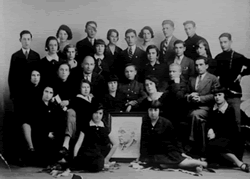 |
#B-085
Before 1937
Pinsk
photo by: Katz
Studio portrait of the Mikhalevich circle of the Yugnt Bund Tsukunft (Bundist youth group), among them A. J. Szlakman (3rd from left, 2nd row) and "Blind" Motl Fishko (seated, 2nd from right). (Two girls hold a portrait of the group's namesake.) |
 |
#B-086
1931
Piotrkow
On a trip: members of the Tsukunft and Morgnshtern, two youth groups of the Jewish Socialist Bund. |
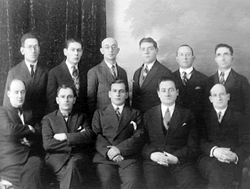 |
#B-087
1920s-30s
Plock photo by: Nowoczesna
Local leaders of the Jewish Socialist Bund gathered for a studio portrait on the occasion of member G. Spector's departure for Switzerland. |
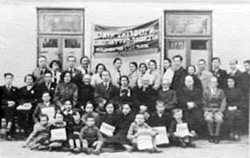 |
#B-088
1937
Pruszkow
Portrait of young and old members of the Jewish Socialist Bund. (Yiddish banner) "Long Live The International Proletariat." |
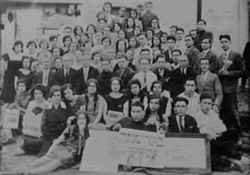 |
#B-089
1930
Pruzhany
Outdoor portrait of members of the Jewish Socialist Bund, posing with a portrait of Vladimir Medem (right). |
 |
#B-090
February 27, 1939
Peremyshl
A board meeting of the I. L. Peretz library dedicated to the 24th anniversary of I. L. Peretz's death, held in the local Jewish Socialist Bund office. The banner (hung on the left wall) reads "Freedom--Equality--Brotherhood." |
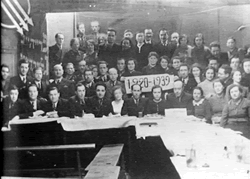 |
#B-091
February 2, 1939
Peremyshl
Group portrait of the board of the I.L. Peretz Library in the Jewish Socialist Bund office during a celebration of the 29th anniversary of the library's founding. |
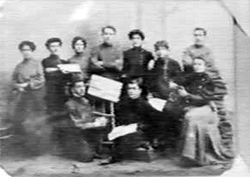 |
#B-092
1906
Radziwillow
Studio portrait of members of the Jewish Socialist Bund. |
 |
#B-093
ca. 1904
Siedlce
Studio portrait of intellectuals and cultural activists: (seated, r-l) Rozenzumen of the Bund; writer and editor Yoshue (Joshua) Goldberg; playwright Yoyel (Joel) Mastbaum; feuilletonist and dramaturg Yankev (Jacob) Tenenboim; (standing, r-l) culture activist Moyshe Mandelman; Peysekh Sapozshnik of the Bund; Avrom Ziklugens; Meyer Slushni, "a revolutionary." |
 |
#B-094
1903
Stressin
Studio portrait of members of the [Jewish Socialist] Bund. ('Jewish Daily Forward' caption in English:) "An interesting group of revolutionaries..." |
 |
#B-095
1902
Lyady
Studio portrait of members of the local organization of the [Jewish Socialist] Bund, young men dressed in the style of Russian proletarians. (Part of a photo essay in the "Jewish Daily Forward," 1927: "Bundist Men And Women Of The Past.") |
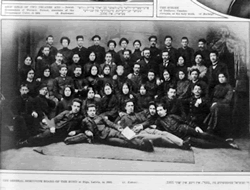 |
#B-096
1905
Riga
Studio portrait: "The General Executive Board of the [Jewish Socialist] Bund in Riga..." ('Jewish Daily Forward' caption, 1928.) |
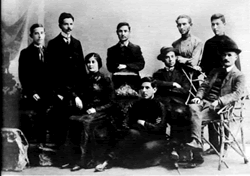 |
#B-097
1906
Kishinev
Studio portrait: "The executive committee of the [Jewish Socialist] Bund in Kishinev... Standing far right is M. L. Polin, now of Baltimore. The woman in the picture is Khayke Polin, his sister." (From "Forward' photo essay on revolutionaries, 1932.) |
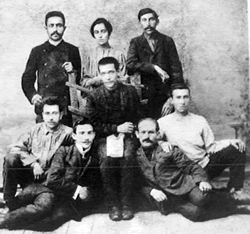 |
#B-098
1904
Berdichev
Studio portrait: seven young men and a woman (standing center), members of the the [Jewish Socialist] Bund. (Part of a 'Jewish Daily Forward' photo spread, 1934: "Jewish Revolutionaries Of The Past.") |
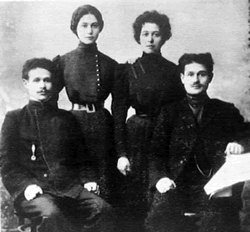 |
#B-099
1905
Vitebsk
Studio portrait: "'Yoshke the tinsmith' and 'Moshke the curly head' -- as these two young people were known in the [Jewish Socialist] Bundist circles... Between them stand the sisters Khane and Mishke, also active in tbe Bund..." ('Forward', 1934.) |
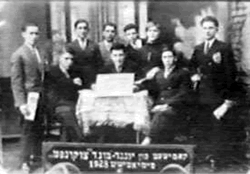 |
#B-100
1928
Siemiatycze
Portrait of the Committee of Tsukunft, the youth movement of the Jewish Socialist Bund: (seated, l-r) Yankl Szmarik (Treasurer); Anshl Czechanowicz (Chairman); Shaye Trotz (Chairman); and M. Zolts, S. Sonenfeld, Zalmen Kominiar, Ides Goldberg and others. |
 |
#B-101
Skidel
Members of Tsukunft, the youth movement of the Jewish Socialist Bund, pose at an outdoor meeting. |
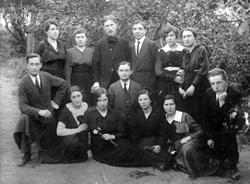 |
#B-102
1917
Skierniewice
Outdoor portrait of men and women members of the Jewish Socialist Bund. |
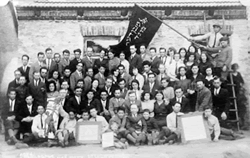 |
#B-103
May 1, 1931
Staszow
photo by: Rotenberg, A.
May Day: members of the Jewish Socialist Bund posing for an outdoor group portrait. The flag reads in Yiddish: "Long Live The Bund." |
 |
#B-104
June 2-3, 1930
Stolin
At the convention: members of Tsukunft (the youth movement of the Jewish Socialist Bund) from Pinsk posing for an outdoor group portrait. |
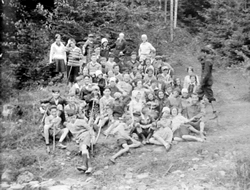 |
#B-105
1930
Sucha
Children from the Medem Sanatorium of the Jewish Socialist Bund on a trip to the mountains. |
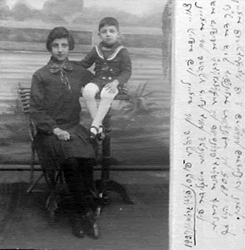 |
#B-106
1927
Svisloch
Studio portrait of 2 children of Leyzer and Soreke Fuks. (Leyzer was a worker in a leather factory, and a memberof the Jewish Socialist Bund. Soreke, a community activist, was known as "Soreke dem bords" (Soreke, Beard's) in reference to her father.) |
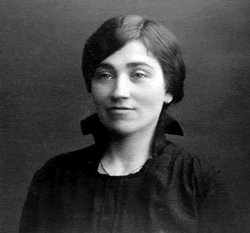 |
#B-107
After World War I
Svisloch
Studio portrait of Neshke Sulies, one of the first women workers to join the Jewish Socialist Bund. She was also active in the 'khevre line' (society to give overnight lodging). |
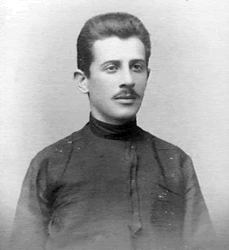 |
#B-108
1908
Svisloch
Vignetted studio portrait of Moyshe Kanengiser, a member of the Jewish Socialist Bund. He worked in a leather factory until 1908 and then moved to Warsaw where he trained as a dental laboratory technician. |
 |
#B-109
1908
Svisloch
Studio portrait of Alter Lewinczyk and an unidentified Russian teacher. (Both were members of the Jewish Socialist Bund.) |
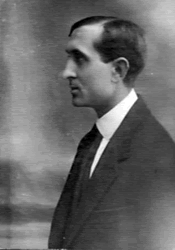 |
#B-110
1919
Szydlowiec
Studio portrait of Weinreich, a leading activist in the local Jewish Socialist Bund. |
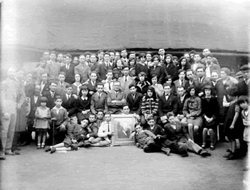 |
#B-111
1928
Tarnow
Outdoor portrait of members of Tsukunft, the youth movement of the Jewish Socialist Bund, posing with a portrait of an unidentified political figure). |
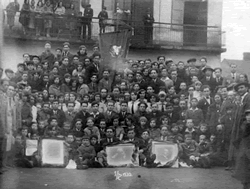 |
#B-112
May 1, 1930
Tarnow
On May Day: members of Tsukunft, the youth movement of the Jewish Socialist Bund, assembled outdoors under a balcony, holding a banner and framed portraits of political figures (including Vladimir Medem and Karl Marx). |
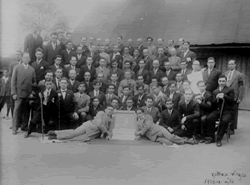 |
#B-113
1929
Tarnow
Group portrait of members of the 'Bundishe boyuvke' (the "tough squad" of the Jewish Socialist Bund) who acted as marshals in the May Day demonstration. (Young men in front hold a framed portrait of an unidentified political figure.) |
 |
#B-114
1927
Tarnow
Outdoor portrait of children and staff of a summer camp for working-class children sponsored by the Jewish Socialist Bund. |
 |
#B-115
January 18, 1933
Tomaszew
Studio portrait of Jakubowicz, a member of the Jewish Socialist Bund. |
 |
#B-116
Late 1930s
Warsaw
Avrumele Szenker's grave, just visited. The tombstone reads in Yiddish: "...the son of Arn and Freyde, shot to death at the age of 5 by fascist murderers" attacking a Bundist May Day demonstration in 1937. (Erected by the City Committee of the Bund.) |
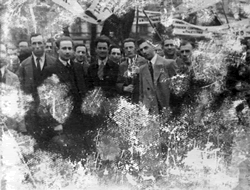 |
#B-117
1936
Warsaw
Young men with banners at a joint May Day demonstration organized by the Jewish Socialist Bund and Poalei-Zion Left (a Labor Zionist party).
|
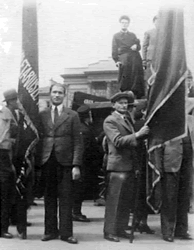 |
#B-118
May 1, 1937
Warsaw
Men stand at attention with banners during a speech by Y. Goldberg at a May Day demonstration organized by the Jewish Socialist Bund. |
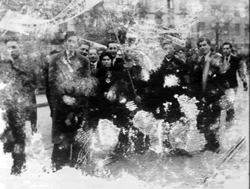 |
#B-119
1936
Warsaw
photo by: Bornstein
Men and women with banners at a joint May Day demonstration organized by the Jewish Socialist Bund and Poalei-Zion Left (a Labor Zionist party). |
 |
#B-120
Warsaw
Studio portrait of Henryk Erlich (1882-1941), a leader of the Jewish Socialist Bund, a city councilman, and member of the board of the Warsaw Kehilla (Jewish community council). |
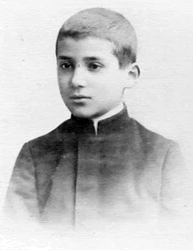 |
#B-121
Warsaw
Vignetted studio portrait of Jewish Socialist Bund leader Victor Alter as a high school student. |
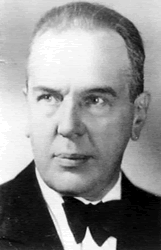 |
#B-122
Warsaw
Studio portrait of Dr. Ludwik Honigwill (1887-1977), lawyer, defender of political cases, vice chairman of the Socialist Lawyers Association in Poland, and a leader of the Jewish Socialist Bund. |
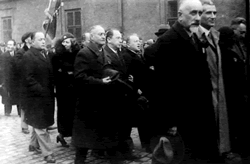 |
#B-123
pub. 1925
Warsaw
A May Day parade of the Jewish Socialist Bund headed by Henryk Erlich and Wiktor Alter. |
 |
#B-124
Warsaw
Ars
Postcard portrait of "Yanek," Yoysef Yankelevitsh (1887-1920), an activist in the Jewish Socialist Bund and the printers' union. |
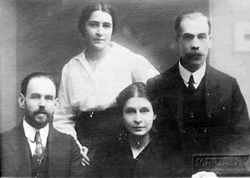 |
#B-125
Warsaw
photo by: Mapjanfuks
Studio prtrait of members of the Jewish Socialist Bund: (right to left) Noyekh (Yekutiel) Portnoy, Felicja Abarbanel, Irenka Goldberg-Kshevitska, and Yerakhmiel Vaynshteyn. |
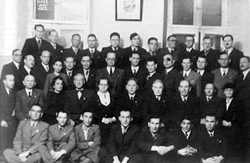 |
#B-126
December 14, 1937
Warsaw
Group portrait of delegates from Galicia to the 40th Anniversary Convention of the Jewish Socialist Bund. |
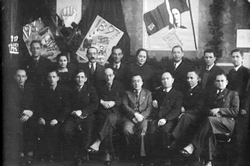 |
#B-127
December, 1937
Warsaw
Portrait of the delegation from Czestochowa at the 40th Anniversary Convention of the Jewish Socialist Bund. |
 |
#B-128
1937
Warsaw
Warsaw newspaper distributors pose at a banquet at the 40th Anniversary Convention of the Jewish Socialist Bund. |
 |
#B-129
1930s
Warsaw
A Jewish Socialist Bund delegation from Amszczonow at the funeral of Josef Leszczynski (Chmurner), a Bundist leader: men and women with wreaths posing in front of the Pol printing shop, which advertises the printing of posters and leaflets. |
 |
#B-130
1930s
Warsaw
photo by: Bornstein
Procession at the funeral of Josef Leszczynski (Chmurner), a leader of the Jewish Socialist Bund. |
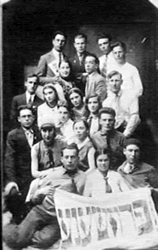 |
#B-131
1931
Warsaw
Delegates from Pruzana pose with a banner at the Nationwide Convention of Tsukunft, the youth movement of the Jewish Socialist Bund. |
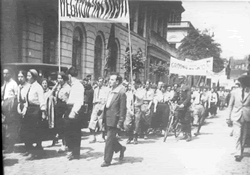 |
#B-132
1931
Warsaw
Delegates from Wegrow, Grodno, and other cities march with banners in a parade at the Nationwide Convention of Tsukunft, the youth movement of the Jewish Socialist Bund. |
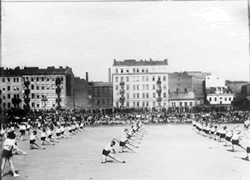 |
#B-133
1931
Warsaw
Girls in an outdoor athletic performance at the Nationwide Convention of Tsukunft, the youth movement of the Jewish Socialist Bund. |
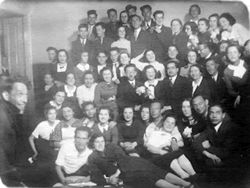 |
#B-134
1936
Warsaw
Young men and women pose at banquet of Tsukunft, the youth movement of the Jewish Socialist Bund. |
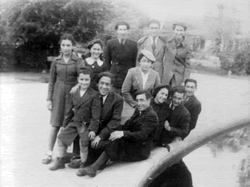 |
#B-135
1937
Warsaw
A group of members of Tsukunft, the youth movement of the Jewish Socialist Bund, pose at the Warsaw Zoo. |
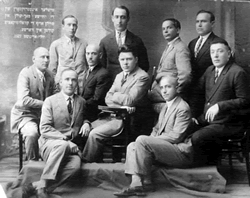 |
#B-136
July-August, 1927
Warsaw
Studio portrait of Leib Berman (seated, center), "a well-known member" of the Jewish Socialist Bund, with other carpentry instructors in Jewish trade schools, in Warsaw for qualifying courses. |
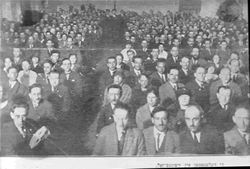 |
#B-137
pub. 1925
Warsaw
Participants of the 2nd Yiddish School Convention at the City Hall: Y. Lev, Y. Rozen, S. Rozenberg, Arn Shenitski, Arn Wahl, Arthur Shmuel Zygelboim. (Yiddish note) "The Left Poalei Zion took up the whole left side; the right side was taken by the Bund." |
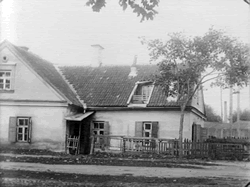 |
#B-138
Vilna
photo by: Grossman, Moryc
The house in which the Jewish Socialist Bund was founded in 1897. |
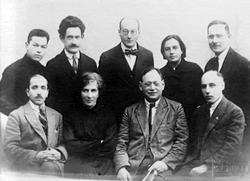 |
#B-139
1923-1924
Vilna
photo by: Brudner, B.
Studio portrait of the Vilna Committee of the Jewish Socialist Bund: (1st row, r-l) Israel Okun, M. Litwak, Anna Rosental, J. Zoleznikow; (2nd row) L. Wajnsztajn, Rebecca Epsztajn, chairman Grisha Abelowicz, Aronowicz. |
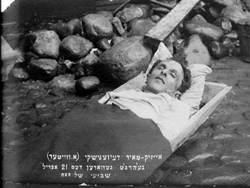 |
#B-140
1919
Vilnius
The body of Arn Wajter (Ajzik Mayer Dejweniszki), active member of the Jewish Socialist Bund and once imprisoned in Siberia. Wajter was shot by a Polish soldier during the 1919 pogroms. |
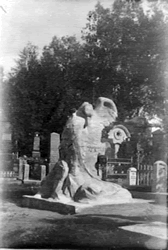 |
#B-141
ca. 1935
Vilnius
photo by: Grossman, Moryc
The tombstone of Arn Wajter (Ajzik Mayer Dejweniszki), a Jewish Socialist Bund activist who was killed by a Polish soldier during the pogroms of 1919. (His tombstone is a statue of the Polish eagle.) |
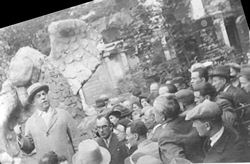 |
#B-142
1935
Vilna
Abraham Morewski speaking at the tomb of Arn Wajter (Ajzik Mayer Dejweniszki), a Jewish Socialist Bund activist who was killed by a Polish soldier during the 1919 pogroms. (His tombstone is a statue of the Polish eagle.) |
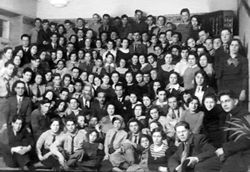 |
#B-143
1934
Vilna
photo by: Szer
Group portrait of members of Tsukunft (the youth movement of the Jewish Socialist Bund) assembled for a banquet with Wirgily Kahan and Zeleznikov (seated near front in center). |
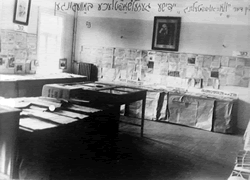 |
#B-144
1933
Vilna
The YIVO exhibit on Jewish social movements: the section on the Jewish Socialist Bund. |
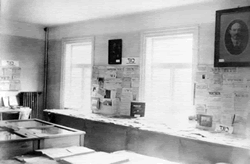 |
#B-145
1933
Vilna
The YIVO exhibit on Jewish social movements: the section on the Jewish Socialist Bund. |
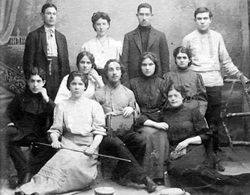 |
#B-146
Before WWI
Vilna
Studio portrait of actor Chaim Schneur ( Hamerow) (standing, right), later a member of the Vilna Troupe, with a group of friends, members of the Jewish Socialist Bund. |
 |
#B-147
1922
Wloclawek
Studio portrait of an unidentified group of children and adults, perhaps associated with the Jewish Socialist Bund. |
 |
#B-148
1920's
Wloclawek
photo by: Shtan
Studio portrait of members of the Jewish Socialist Bund. |
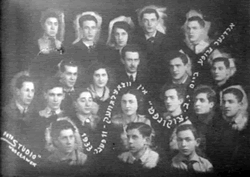 |
#B-149
1933
Wloclawek
photo by: Bernardi
Montage of portraits of members of Tsukunft, the youth movement of the Jewish Socialist Bund. |
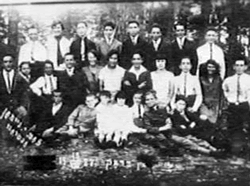 |
#B-150
August 15, 1927
Brok
photo by: Neyman, Y.
Formal group portrait in the woods: unidentified members of Tsukunft (Jewish Socialist Bund youth movement). |
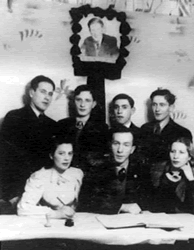 |
#B-151
1930s
Zamosc
phopto by: Ginsburg, M.
Members of Tsukunft, the youth movement of the Jewish Socialist Bund, posing with the black-shrouded portrait of a dead comrade and a banner reading, "Long live the `Yugnt Bund Zukunft'." |
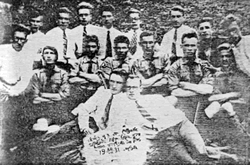 |
#B-152
1931
Zaromb
Group portrait of members of Yugnt, the youth movement of the Jewish Socialist Bund. |
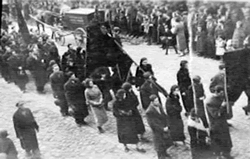 |
#B-153
1930s
Zdunska Wola
A funeral procession for an unidentified member of the Jewish Socialist Bund. |
 |
#B-0154
July 28, 1928
Zdunska Wola
Group portrait of participants in the "4th Outing" of Tsukunft, the youth movement of the Jewish Socialist Bund. |
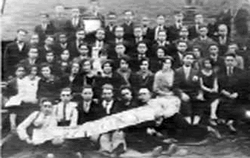 |
#B-155
Zelechow
Outdoor portrait of members of Tsukunft, the youth movement of the Jewish Socialist Bund. |
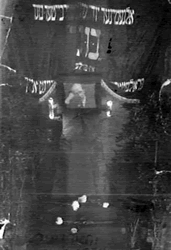 |
#B-156
After 1923
Poland
A memorial for Bundist leader Vladimir Medem, with the banner of the Jewish Socialist Bund and a picture of Medem. |
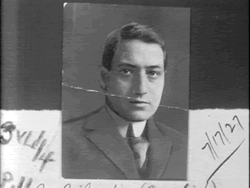 |
#B-157
1927
Poland
Heavily retouched portrait of G. Sibert, journalist, member of the Jewish Socialist Bund, and chairman of the emigration office of the national council of the clothing workers' union. |
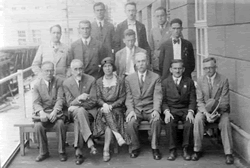 |
#B-158
1931
Vienna
The Bund delegation to the Socialist International: (sitting l-r) Y. Likhtenshteyn, H. Erlich, A. Rosental, Noyekh, A. Zelmanovitsh, Kh. Peskin; (2nd row) G. Zibert, V. Alter, Kh. Pizhits (?), E. Sherer; (3rd row) Sh. Hertz, E. Novogrodski, M. Ozhekh. |
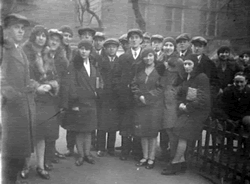 |
#B-159
1920s-30s
Poland
On an outing: members of Tsukunft and Morgnshtern (youth movements of the Jewish Socialist Bund) posing together on a walk. |
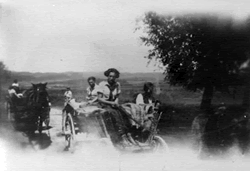 |
#B-160
On an outing: members of Tsukunft and Morgnshtern (youth organizations of the Jewish Socialist Bund) posing together on a walk. |
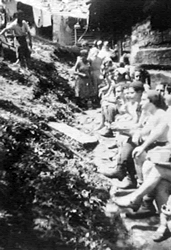 |
#B-161
ca. 1935
Carpathia
Members of Tsukunft (the youth movement of the Jewish Socialist Bund) sitting together along the side of a wooden building, at a summer camp in the mountains, "at the time of the famous flood." |
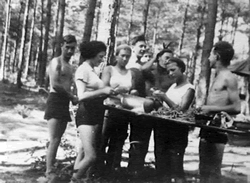 |
#B-162
ca. 1935
Carpathia
"The household committee" cutting vegetables in a clearing in the woods at a summer camp in the mountains for members of Tsukunft, the youth movement of the Jewish Socialist Bund. |
 |
#B-163
ca. 1935
Carpathia
Teenagers posing in front of a fence, at a summer camp in the mountains for members of Tsukunft, the youth movement of the Jewish Socialist Bund. |
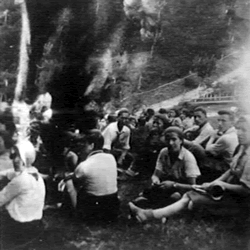 |
#B-164
ca. 1935
Carpathia
Teenagers resting on a hillside, while on an outing at a summer camp for members of Tsukunft, the youth movement of the Jewish Socialist Bund. |
 |
#B-165
ca. 1935
Carpathia
"At our field kitchens" in the woods, at a summer camp in the mountains for members of Tsukunft, the youth movement of the Jewish Socialist Bund. |
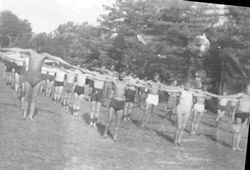 |
#B-166
ca. 1935
Carpathia
Rows of campers doing calisthenics "on the gymnastics field" at a summer camp in the mountains for members of Tsukunft, the youth movement of the Jewish Socialist Bund. |
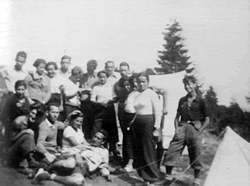 |
#B-167
c. 1935
Carpathia
Campers posing together by their tents at a summer camp in the mountains for members of Tsukunft, the youth movement of the Jewish Socialist Bund. |
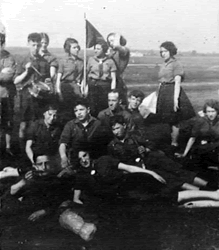 |
#B-168
May 22-23, 1931
Poland
Members of Tsukunft, the youth movement of the Jewish Socialist Bund, in uniform, posing together on the grass at a summer camp with the movement's red flag. |
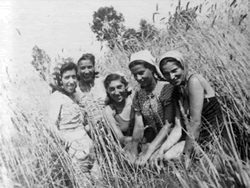 |
#B-169
ca. 1930s
Poland
Pola Kirszencwajg, Khayke Belchatowska, Miriam Szyfman and two other young women, some or all of whom were associated with the Jewish Socialist Bund, posing together in a rye field. |
 |
#B-170
1934
Poland
On a sailing trip from Warsaw to Gdynia: members of Morgnshtern (the sports organization of the Jewish Socialist Bund) posing on the ship's mast. |
 |
#B-171
1934
Poland
On a sailing trip from Warsaw to Gdynia: members of Morgnshtern (the sports organization of the Jewish Socialist Bund) posing for a group portrait with the crew on the boat at the pier. |
 |
#B-172
1930
Miedzeszyn
A group of children playing a ring toss game indoors, at the Medem Sanatorium, run by the Jewish Socialist Bund. (From an album.) |
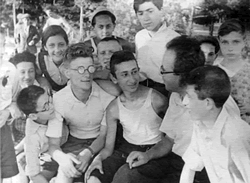 |
#B-173
1930
Miedzeszyn
Youngsters grouped around their teacher Yoysef Katz, outdoors at the Medem Sanatorium, run by the Jewish Socialist Bund. In the group are Sholem Rosenberg (seated, right) and Yosl (Joseph) Mlotek (left, with glasses). (From an album.) |
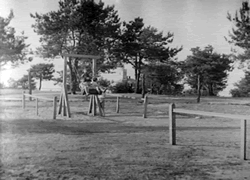 |
#B-174
1930
Michalin
Children on a swing on the grounds of the Medem Sanatorium, run by the Jewish Socialist Bund. (From an album.) |
 |
#B-175
1930
Michalin
A group of boys playing croquet, on the grounds of the Medem Sanatorium, run by the Jewish Socialist Bund. (From an album.) |
 |
#B-176
1930
Michalin
Two girls playing a toss game together, on the grounds of the Medem Sanatorium, run by the Jewish Socialist Bund. (From an album.) |
 |
#B-177
1930
Miedzeszyn
Children playing in a playground at the Medem Sanatorium, run by the Jewish Socialist Bund. (From an album.) |
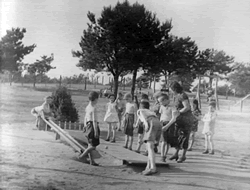 |
#B-178
1930
Michalin
A group of children playing a bowling game on the grounds of the Medem Sanatorium, run by the Jewish Socialist Bund. (From an album.) |
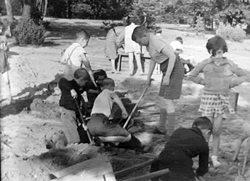 |
#B-179
1930
Miedzeszyn
Children digging in a sand pit with shovels and wheelbarrows, on the grounds of the Medem Sanatorium, run by the Jewish Socialist Bund. (From an album.) |
 |
#B-180
1930
Miedzeszyn
Children grouped around their teacher Manye Yerukhamzon, serving tea, outdoors at the Medem Sanatorium, run by the Jewish Socialist Bund. (From an album.) |
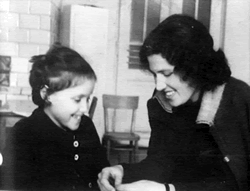 |
#B-181
1930
Michalin
Teacher Guta Segalowicz-Kac with a child at the Medem Sanatorium, run by the Jewish Socialist Bund. (From an album.) |
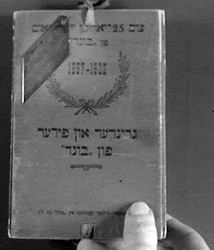 |
#B-182
1922
Poland
"For the 25th anniversary of the Bund. 1897-1922. Founders and leaders of the Bund": cover of an album of portraits of Jewish Socialist Bund activists. |
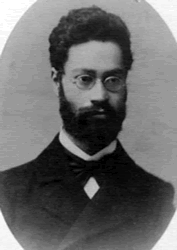 |
#B-183
Arkadi Kremer, one of the founders and leaders of the Jewish Socialist Bund (whose portraits were included by the Vilna Committee of the Bund in an album honoring the party's 25th anniversary in 1922). |
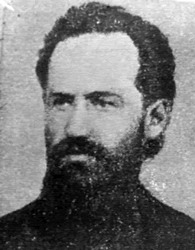 |
#B-184
Isaiah (Vitaly)Eisenstadt, one of the founders and leaders of the Jewish Socialist Bund (whose portraits were included by the Vilna Committee of the Bund in an album honoring the party's 25th anniversary in 1922). |
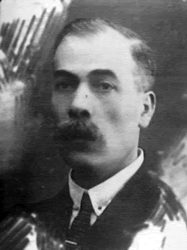 |
#B-185
Noah Portnoy, one of the founders and leaders of the Jewish Socialist Bund (whose portraits were included by the Vilna Committee of the Bund in an album honoring the party's 25th anniversary in 1922). |
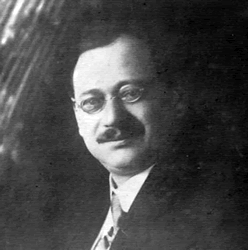 |
#B-186
A. Litvak (Khaim Helfand), one of the founders and leaders of the Jewish Socialist Bund (whose portraits were included by the Vilna Committee of the Bund in an album honoring the party's 25th anniversary in 1922.) |
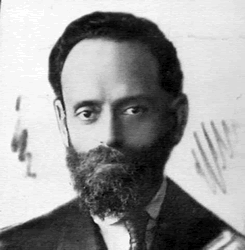 |
#B-187
Mark Liber, one of the founders and leaders of the Jewish Socialist Bund (whose portraits were included by the Vilna Committee of the Bund in an album honoring the party's 25th anniversary in 1922). |
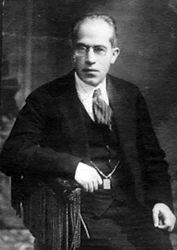 |
#B-188
Yosef Izbitski, one of the founders and leaders of the Jewish Socialist Bund (whose portraits were included by the Vilna Committee of the Bund in an album honoring the party's 25th anniversary in 1922). |
 |
#B-189
Vladimir Kosovsky (Nakhum Levinson), one of the founders and leaders of the Jewish Socialist Bund (whose portraits were included by the Vilna Committee of the Bund in an album honoring the party's 25th anniversary in 1922). |
 |
#B-190
Bronislaw Groser, one of the founders and leaders of the Jewish Socialist Bund (whose portraits were included by the Vilna Committee of the Bund in an album honoring the party's 25th anniversary in 1922). |
 |
#B-191
Vladimir Medem, one of the founders and leaders of the Jewish Socialist Bund (whose portraits were included by the Vilna Committee of the Bund in an album honoring the party's 25th anniversary in 1922). |
 |
#B-192
P. Arman (Dr. Pavel Rozental), one of the founders and leaders of the Jewish Socialist Bund (whose portraits were included by the Vilna Committee of the Bund in an album honoring the party's 25th anniversary in 1922). |
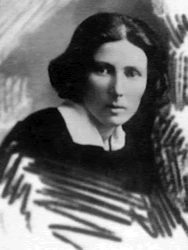 |
#B-193
Sore Fuks, one of the leaders and founders of the Jewish Socialist Bund (whose portraits were included by the Vilna Committee of the Bund in an album honoring the party's 25th anniversary in 1922.) |
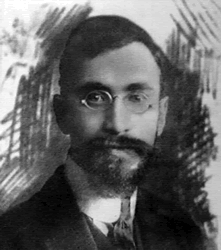 |
#B-194
Raphael Abramovitch, one of the leaders and founders of the Jewish Socialist Bund (whose portraits were included by the Vilna Committee of the Bund in an album honoring the party's 25th anniversary in 1922.) |
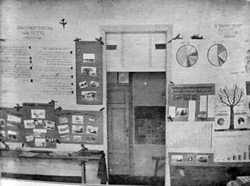 |
#B-195
12/28/90-1/8/90
Warsaw
A display on the Medem Sanatorium of the Jewish Socialist Bund at the second exhibition of CYSHO (Central Yiddish School Association). (From an album published by CYSHO.) |
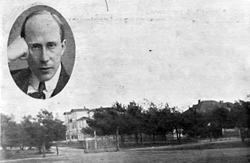 |
#B-196
1929
Michalin
View of the entrance to the Medem Sanatorium of the Jewish Socialist Bund, with an inset of Vladimir Medem. (Issued as a postcard as part of a series for the 2nd national exhibition of CYSHO [Central Yiddish School Organization].) |
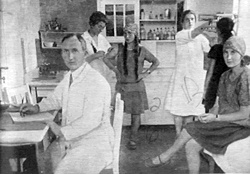 |
#B-197
1930
Miedzeszyn
The clinic at the Medem Sanatorium of the Jewish Socialist Bund. (Issued as a postcard as part of a series for the 2nd national exhibition of CYSHO [Central Yiddish School Organization].) |
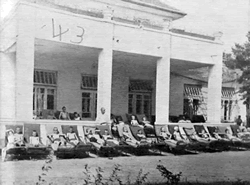 |
#B-198
1930
Miedzeszyn
Children sunning and resting on chaises at the "rest pavilion" of the "new building" at the Medem Sanatorium of the Jewish Socialist Bund. (Issued as a postcard in a series for the 2nd national exhibition of CYSHO [Central Yiddish School Organization].) |
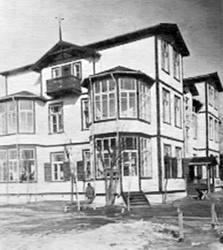 |
#B-199
1929
Miedzeszyn
The "old building" at the Medem Sanatorium of the Jewish Socialist Bund. (Issued as a postcard as part of a series for the 2nd national exhibition of CYSHO [Central Yiddish School Organization].) |
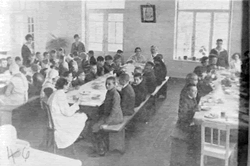 |
#B-200
1930
Michalin
At a meal in the dining room of the Medem Sanatorium of the Jewish Socialist Bund. (Issued as a postcard as part of a series for the 2nd national exhibition of CYSHO [Central Yiddish School Organization].) |
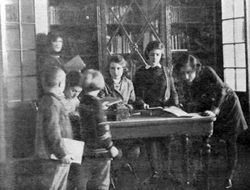 |
#B-201
1930
Michalin
Children around the librarian's table in the library of the Medem Sanatorium of the Jewish Socialist Bund. (Issued as a postcard as part of a series for the 2nd national exhibition of CYSHO [Central Yiddish School Organization].) |
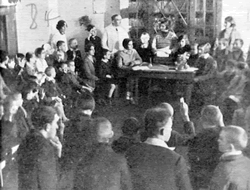 |
#B-202
1929
Miedzeszyn
A vote at a meeting of the children's council of the Medem Sanatorium of the Jewish Socialist Bund. (Issued as a postcard as part of a series for the 2nd national exhibition of CYSHO [Central Yiddish School Organization].) |
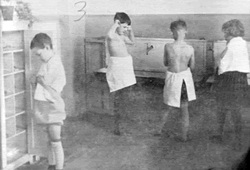 |
#B-203
1930
Miedzeszyn
In the washroom at the Medem Sanatorium of the Jewish Socialist Bund: three boys and a girl, by the sinks and at a cubby. (Issued as a postcard as part of a series for the 2nd national exhibition of CYSHO [Central Yiddish School Organization].) |
 |
#B-204
1930
Michalin
"Out in the open": a group of young boys and girls, dressed for sun-bathing, posing on the grass with teacher Sheyne Pat and another teacher at the Medem Sanatorium of the Jewish Socialist Bund. (Part of a CYSHO postcard series.) |
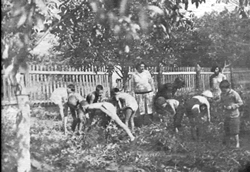 |
#B-205
1930
Miedzeszyn
"At work in the garden" of the Medem Sanatorium of the Jewish Socialist Bund. (Issued as a postcard as part of a series for the 2nd national exhibition of CYSHO [Central Yiddish School Organization].) |
 |
#B-206
1920's
Kiev
photo by: Pashker, M. Z.
Students (five women and a man) at their jobs in a "shoe-making workshop named after [Jewish Socialist Bund leader] Lekert" (in Yiddish). |
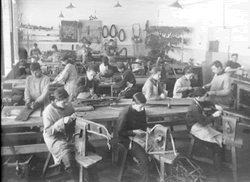 |
#B-207
1920's
Kiev
Pashker, M. Z.
Students pose making harnesses in a "workshop at the school named after [Jewish Socialist Bund leader] H. Lekert" (in Yiddish). |
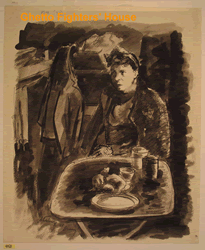 |
#B-208
Aizik - Adolphe Feder: A Jewish Adolescent Girl, Seated
Type of Item: Artwork
Catalog No.: 452
Databank: Art Collection
Aizik - Adolphe Feder: A Jewish Adolescent Girl, Seated Drawing made in the Drancy camp, Jan. 9, 1943 Aizik - Adolphe Feder was born on July 16, 1887, to a Jewish mercantile family in Odessa. In 1905, he joined the Bund. Persecuted for his activities, he fled to Berlin. He studied art there and ... |
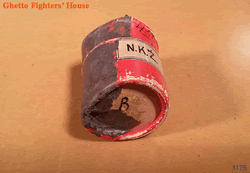 |
#B-209
A microfilm reel smuggled by the Jewish underground out of Warsaw to London on 24 May 1944
Catalog No.: 1175
Type of Item: Artifact
Databank: Artifacts Section
Description: 1. A microfilm reel smuggled by the Jewish underground out of Warszawa (Warsaw) to London on 24 May 1944 2. A cardboard cylinder box used to carry the microfilm reel. On 24 May 1944, Jewish National Committee (ZKN - Zydowski Komitet Narodowy) activists and Bund men in Warsaw, working ... |
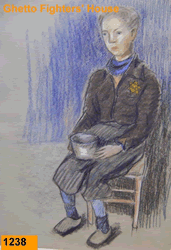 |
#B-210
Aizik - Adolphe Feder: Seated Boy, Holding a Dish of Food
Type of Item: Artwork
Catalog No.: 1238
Databank: Art Collection
Aizik - Adolphe Feder: Seated Boy, Holding a Dish of Food Painting made in the Drancy camp. Aizik - Adolphe Feder was born on July 16, 1887, to a Jewish mercantile family in Odessa. In 1905, he joined the Bund. Persecuted for his activities, he fled to Berlin. He studied art there and in Geneva ... |
 |
#B-211
Aizik - Adolphe Feder: Young Woman, Seated, Holding a Book
Type of Item: Artwork
Catalog No.: 1223
Databank: Art Collection
Aizik - Adolphe Feder: Young Woman, Seated, Holding a Book Painting made in the Drancy camp, Nov. 30, 1942 Aizik - Adolphe Feder was born on July 16, 1887, to a Jewish mercantile family in Odessa. In 1905, he joined the Bund. Persecuted for his activities, he fled to Berlin. He studied art there ... |
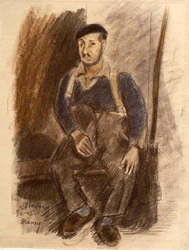 |
#B-212
Aizik - Adolphe Feder: Seated Man Wearing a Beret
Type of Item: Artwork
Catalog No.: 1222
Databank: Art Collection
Aizik - Adolphe Feder: Seated Man Wearing a Beret Painting made in the Drancy camp, Dec. 9, 1942 Aizik - Adolphe Feder was born on July 16, 1887, to a Jewish mercantile family in Odessa. In 1905, he joined the Bund. Persecuted for his activities, he fled to Berlin. He studied art there and in Geneva ... |
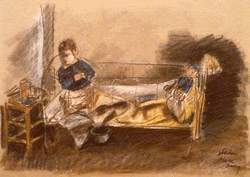 |
#B-213
Aizik - Adolphe Feder: Young Boy with a Doll, in Bed
Type of Item: Artwork
Catalog No.: 1218
Databank: Art Collection
Aizik - Adolphe Feder: Young Boy with a Doll, in Bed Painting made in the Drancy camp, Dec. 31, 1942 Aizik - Adolphe Feder was born on July 16, 1887, to a Jewish mercantile family in Odessa. In 1905, he joined the Bund. Persecuted for his activities, he fled to Berlin. He studied art there and in ...
|
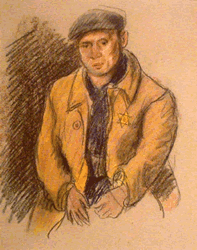 |
#B-214
Aizik - Adolphe Feder: Young Jew, Seated, with a Yellow Badge
Type of Item: Artwork
Catalog No.: 1219
Databank: Art Collection
Aizik - Adolphe Feder: Young Jew, Seated, with a Yellow Badge Aizik - Adolphe Feder was born on July 16, 1887, to a Jewish mercantile family in Odessa. In 1905, he joined the Bund. Persecuted for his activities, he fled to Berlin. He studied art there and in Geneva (Geneve) during the years 1908 ... |
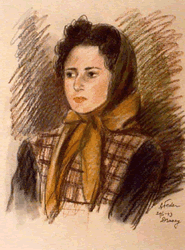 |
#B-215
Aizik - Adolphe Feder: Portrait of Young Woman with a Headscarf
Type of Item: Artwork
Catalog No.: 1221
Databank: Art Collection
Aizik - Adolphe Feder: Portrait of Young Woman with a Headscarf Aizik - Adolphe Feder was born on July 16, 1887, to a Jewish mercantile family in Odessa. In 1905, he joined the Bund. Persecuted for his activities, he fled to Berlin. He studied art there and in Geneva (Geneve) during the years 1908 ... |
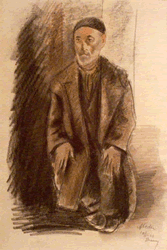 |
#B-216
Aizik - Adolphe Feder: Seated Jew Wearing a Skullcap
Type of Item: Artwork
Catalog No.: 1227
Databank: Art Collection
Aizik - Adolphe Feder: Seated Jew Wearing a Skullcap Painting made in the Drancy camp, Jan. 10, 1943 Aizik - Adolphe Feder was born on July 16, 1887, to a Jewish mercantile family in Odessa. In 1905, he joined the Bund. Persecuted for his activities, he fled to Berlin. He studied art there and in ... |
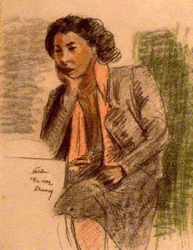 |
#B-217
Aizik - Adolphe Feder: Young Woman Seated Beside a Table
Type of Item: Artwork
Catalog No.: 1226
Databank: Art Collection
Aizik - Adolphe Feder: Young Woman Seated Beside a Table Painting made in the Drancy camp, Dec. 17, 1942 Aizik - Adolphe Feder was born on July 16, 1887, to a Jewish mercantile family in Odessa. In 1905, he joined the Bund. Persecuted for his activities, he fled to Berlin. He studied art there and ... |
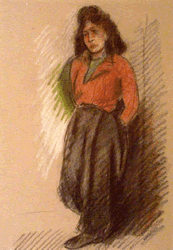 |
#B-218
Aizik - Adolphe Feder: Teenaged Girl, Standing
Type of Item: Artwork
Catalog No.: 1225
Databank: Art Collection
Aizik - Adolphe Feder: Teenaged Girl, Standing Aizik - Adolphe Feder was born on July 16, 1887, to a Jewish mercantile family in Odessa. In 1905, he joined the Bund. Persecuted for his activities, he fled to Berlin. He studied art there and in Geneva (Geneve) during the years 1908 - 1909. In 1910 ... |
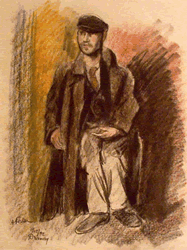 |
#B-219
Aizik - Adolphe Feder: Young Man in an Overcoat, Standing
Type of Item: Artwork
Catalog No.: 1224
Databank: Art Collection
Aizik - Adolphe Feder: Young Man in an Overcoat, Standing Painting made in the Drancy camp, Dec. 17, 1942 Aizik - Adolphe Feder was born on July 16, 1887, to a Jewish mercantile family in Odessa. In 1905, he joined the Bund. Persecuted for his activities, he fled to Berlin. He studied art there ... |
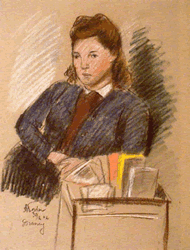 |
#B-220
Aizik - Adolphe Feder: Young Woman behind a Table with a Box of Books
Type of Item: Artwork
Catalog No.: 1220
Databank: Art Collection
Aizik - Adolphe Feder: Young Woman behind a Table with a Box of Books Painting made in the Drancy camp, Dec. 30, 1942 Aizik - Adolphe Feder was born on July 16, 1887, to a Jewish mercantile family in Odessa. In 1905, he joined the Bund. Persecuted for his activities, he fled to Berlin. He studied ... |
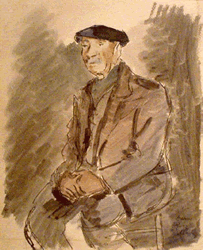 |
#B-221
Aizik - Adolphe Feder: Seated Man Wearing a Beret
Type of Item: Artwork
Catalog No.: 1231
Databank: Art Collection
Aizik - Adolphe Feder: Seated Man Wearing a Beret Painting made in the Drancy camp, Nov. 20, 1942 Aizik - Adolphe Feder was born on July 16, 1887, to a Jewish mercantile family in Odessa. In 1905, he joined the Bund. Persecuted for his activities, he fled to Berlin. He studied art there and in Geneva ... |
 |
#B-222
Aizik - Adolphe Feder: Seated Jew with a Yellow Badge
Type of Item: Artwork
Catalog No.: 1229
Databank: Art Collection
Aizik - Adolphe Feder: Seated Jew with a Yellow Badge Painting made in the Drancy camp, Feb. 1, 1943 Aizik - Adolphe Feder was born on July 16, 1887, to a Jewish mercantile family in Odessa. In 1905, he joined the Bund. Persecuted for his activities, he fled to Berlin. He studied art there and in ... |
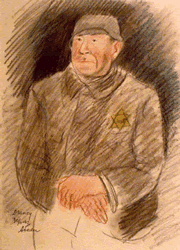 |
#B-223
Aizik - Adolphe Feder: Seated Jew with a Yellow Badge
Type of Item: Artwork
Catalog No.: 1228
Databank: Art Collection
Aizik - Adolphe Feder: Seated Jew with a Yellow Badge Painting made in the Drancy camp, Nov. 30, 1942 Aizik - Adolphe Feder was born on July 16, 1887, to a Jewish mercantile family in Odessa. In 1905, he joined the Bund. Persecuted for his activities, he fled to Berlin. He studied art there and ... |
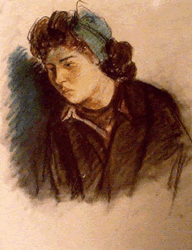 |
#B-224
Aizik - Adolphe Feder: Young Woman with a Green Ribbon in her Hair
Type of Item: Artwork
Catalog No.: 1233
Databank: Art Collection
Aizik - Adolphe Feder: Young Woman with a Green Ribbon in her Hair Aizik - Adolphe Feder was born on July 16, 1887, to a Jewish mercantile family in Odessa. In 1905, he joined the Bund. Persecuted for his activities, he fled to Berlin. He studied art there and in Geneva (Geneve) during the years ... |
 |
#B-225
Aizik - Adolphe Feder: Young Jew Wearing a Yellow Badge, Seated with a Book on his Knees
Type of Item: Artwork
Catalog No.: 1235
Databank: Art Collection
Aizik - Adolphe Feder: Young Jew Wearing a Yellow Badge, Seated with a Book on his Knees Aizik - Adolphe Feder was born on July 16, 1887, to a Jewish mercantile family in Odessa. In 1905, he joined the Bund. Persecuted for his activities, he fled to Berlin. He studied art there and in Geneva (Geneve) ... |
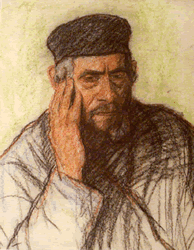 |
#B-226
Aizik - Adolphe Feder: Portrait of a Seated Man, his Head Resting on his Hand
Type of Item: Artwork
Catalog No.: 1230
Databank: Art Collection
Aizik - Adolphe Feder: Portrait of a Seated Man, his Head Resting on his Hand Aizik - Adolphe Feder was born on July 16, 1887, to a Jewish mercantile family in Odessa. In 1905, he joined the Bund. Persecuted for his activities, he fled to Berlin. He studied art there and in Geneva (Geneve) during ... |
 |
#B-227
Aizik - Adolphe Feder, Self - Portrait with Yellow Badge.
Type of Item: Artwork
Catalog No.: 1271
Databank: Art Collection
Aizik - Adolphe Feder: Self - Portrait with Yellow Badge. Aizik - Adolphe Feder was born on July 16, 1887, to a Jewish mercantile family in Odessa. In 1905, he joined the Bund. Persecuted for his activities, he fled to Berlin. He studied art there and in Geneva (Geneve) during the years 1908 - 1909. ... |
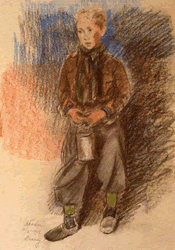 |
#B-228
Aizik - Adolphe Feder: Boy Wearing a Yellow Badge, Holding a Metal Can
Type of Item: Artwork
Catalog No.: 1236
Databank: Art Collection
Aizik - Adolphe Feder: Boy Wearing a Yellow Badge, Holding a Metal Can Painting made in the Drancy camp, Dec. 26, 1942 Aizik - Adolphe Feder was born on July 16, 1887, to a Jewish mercantile family in Odessa. In 1905, he joined the Bund. Persecuted for his activities, he fled to Berlin. He studied ... |
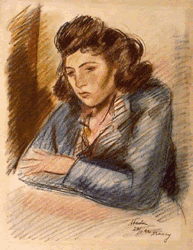 |
#B-229
Aizik - Adolphe Feder: Young Woman at a Table
Type of Item: Artwork
Catalog No.: 1237
Databank: Art Collection
Aizik - Adolphe Feder: Young Woman at a Table Aizik - Adolphe Feder was born on July 16, 1887, to a Jewish mercantile family in Odessa. In 1905, he joined the Bund. Persecuted for his activities, he fled to Berlin. He studied art there and in Geneva (Geneve) during the years 1908 - 1909. In 1910 ... |
 |
#B-230
Aizik - Adolphe Feder: Seated Internee
Type of Item: Artwork
Catalog No.: 1239
Databank: Art Collection
Aizik - Adolphe Feder: Seated Internee Aizik - Adolphe Feder was born on July 16, 1887, to a Jewish mercantile family in Odessa. In 1905, he joined the Bund. Persecuted for his activities, he fled to Berlin. He studied art there and in Geneva (Geneve) during the years 1908 - 1909. In 1910 he went ... |
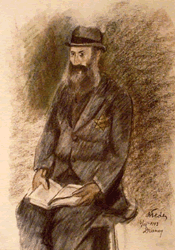 |
#B-231
Aizik - Adolphe Feder: Seated Jew Wearing a Yellow Badge, with a Book on his Knees
Type of Item: Artwork
Catalog No.: 1232
Databank: Art Collection
Aizik - Adolphe Feder: Seated Jew Wearing a Yellow Badge, with a Book on his Knees Painting made in the Drancy camp, Dec. 16, 1942 Aizik - Adolphe Feder was born on July 16, 1887, to a Jewish mercantile family in Odessa. In 1905, he joined the Bund. Persecuted for his activities, he fled to Berlin. ... |
 |
#B-232
Wladka (Miedzyrzecki - Meed, formerly Feygl Peltel): Forged "Aryan" ID card
Catalog No.: 473
Databank: Collections Section
Type of Item: Archive - file
Wladka (Miedzyrzecki - Meed, formerly Feygl Peltel): her forged "Aryan" ID card, issued to Stanislawa Wenchleska. Also in the file: transcript of Bar Mitzvah speech by Shlomo Meed, Wladka's son; 15 Feb. 1964; eight pages, typewritten original, in Yiddish Note: Wladka, a native of Warsaw, was a member ... |
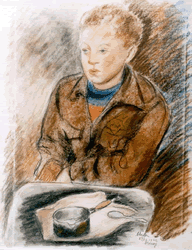 |
#B-233
Aizik - Adolphe Feder: Boy with a Yellow Badge, Seated at a Laid Table
Type of Item: Artwork
Catalog No.: 1234
Databank: Art Collection
Aizik - Adolphe Feder: Boy with a Yellow Badge, Seated at a Laid Table Painting made in the Drancy camp, Dec. 24, 1942 Aizik - Adolphe Feder was born on July 16, 1887, to a Jewish mercantile family in Odessa. In 1905, he joined the Bund. Persecuted for his activities, he fled to Berlin. He studied ... |
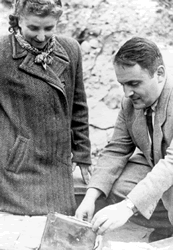 |
#B-234
Hirsch Wasser, photographed upon the discovery of part of the hidden Oneg Shabbat archive in Warsaw on Sept. 18, 1942.
Catalog No.: 497
Type of Item: Photo
Databank: Photo Archive
Hirsch Wasser, photographed upon the discovery of part of the buried "Oneg Shabbat" archives in Warsaw on September 18, 1942. Standing next to him is Rachel Auerbach. Note: Hirsch Wasser, born in 1912 in Suwalki, Poland, was a member of the Po'alei Zion - Left party and secretary of the clandestine ... |
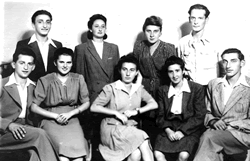 |
#B-235
Nine members of the Jewish Fighting Organization in the Warsaw ghetto.
Catalog No.: 962
Type of Item: Photo
Databank: Photo Archive
Nine members of the Jewish Fighting Organization (ZOB) in the Warsaw (Warszawa) ghetto. In the photo: Oskar Hendler (standing, right), Chaim Frimer (seated, right), Masza Bagner - Fischer (seated, second from the right), Pnina Grinshpan - Frimer (seated, third from the right), Irena Gelblum ... |
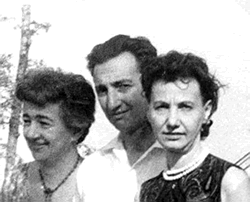 |
#B-236
Three members of the Jewish underground in Warsaw in 1963.
Catalog No.: 974
Type of Item: Photo
Databank: Photo Archive
Three members of the Jewish underground in Warsaw (Warszawa) in 1963. In the photo: Marek Edelman, Feygl Peltel - Miedzyrzecka (now Wladka Meed, on the right) and Chana Fryszdorf - Krisztal. The three were members of the Bund and the Jewish Fighting Organization. |
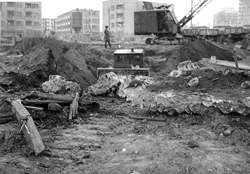 |
#B-237
The ruins of the bunker at the end of Mila Street, at the corner of Smocza Street in Warsaw.
Catalog No.: 975
Type of Item: Photo
Databank: Photo Archive
The ruins of the bunker at the end of Mila Street, at the corner of Smocza Street in Warsaw (Warszawa). This was the location of the Jewish Fighting Organization squad under the command of Wolf Rozowski of the Bund. |
 |
#B-238
The ruins of the bunker at the end of Mila Street, at the corner of Smocza Street in Warsaw.
Catalog No.: 976
Type of Item: Photo
Databank: Photo Archive
The ruins of the bunker at the end of Mila Street, at the corner of Smocza Street in Warsaw (Warszawa). This was the location of the Jewish Fighting Organization squad under the command of Wolf Rozowski of the Bund. |
 |
#B-239
A group of veterans of the Jewish Fighting Organization who joined up with the partisans.
Catalog No.: 982
Type of Item: Photo
Databank: Photo Archive
A group of veterans of the Jewish Fighting Organization who joined up with the partisans. Photographed in Nowy Dwor in 1944. In the photo: Jakov Bilek (on the right), Gabriel Fryszdorf (second from the right), Chana Fryszdorf (third from the right), Yurek Kiriat Sefer (fourth from the right), Yakov ... |
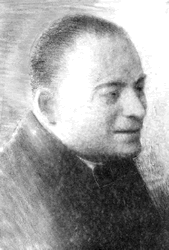 |
#B-240
Maurycy Orzech, a member of the Bund Central Committee and the Jewish underground in the Warsaw ghetto.
Catalog No.: 1015
Type of Item: Photo
Databank: Photo Archive
Maurycy Orzech, a member of the Bund Central Committee and the Jewish underground in the Warsaw (Warszawa) ghetto. Note: When war broke out , he escaped to Latvia and from there tried to reach Sweden by a sea route, but the ship was stopped by the Germans and he was returned to Poland. Orzech participated ... |
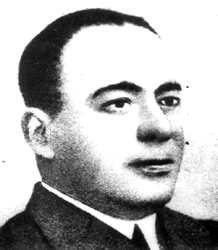 |
#B-241
Maurycy Orzech, a member of the Bund Central Committee and the Jewish underground in the Warsaw ghetto.
Catalog No.: 1016
Type of Item: Photo
Databank: Photo Archive
Maurycy Orzech, a member of the Bund Central Committee and the Jewish underground in the Warsaw (Warszawa) ghetto. For details about him, see Photo No. 1015. |
 |
#B-242
Zygmunt Igla, native of Poland, member of the Bund and the Jewish underground in the Warsaw ghetto.
Catalog No.: 1020
Type of Item: Photo
Databank: Photo Archive
Zygmunt Igla, native of Poland, member of the Bund and the Jewish underground in the Warsaw (Warszawa) ghetto. Note: During the ghetto uprising in April 1943, Igla fought under the command of Wolf Rozowski. Igla was among those who escaped from the ghetto via the sewers to join with the partisans ... |
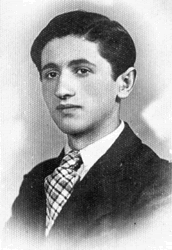 |
#B-243
Jakov Bilek ("Janek"), member of the Bund and the Jewish underground in the Warsaw ghetto.
Catalog No.: 1051
Type of Item: Photo
Databank: Photo Archive
Jakov Bilek ("Janek"), member of the Bund and the Jewish underground in the Warsaw (Warszawa) ghetto. Photographed in 1944. Note: Bilek participated in the Warsaw ghetto uprising in April 1943, fighting in the Brushmakers' Area and afterwards in the Central Ghetto. With the suppression of the uprising, ... |
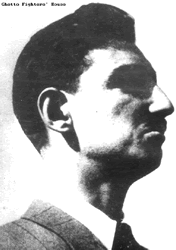 |
#B-244
Marek Edelman, among the leaders of the Bund and a commander in the Warsaw ghetto uprising.
Catalog No.: 1059
Type of Item: Photo
Databank: Photo Archive
Marek Edelman, among the leaders of the Bund and a commander in the Warsaw (Warszawa) ghetto uprising. Notes: 1) Edelman was born in Warsaw in 1926. As a teenager, he joined Tsukunft, the Bund's youth movement, and became a member in the party's central institutions. In November 1942 he joined the ... |
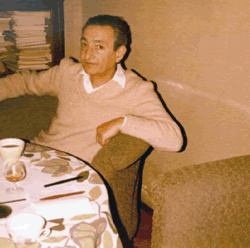 |
#B-245
Marek Edelman, among the leaders of the Bund and a commander in the Warsaw ghetto uprising.
Catalog No.: 1060
Type of Item: Photo
Databank: Photo Archive
Marek Edelman, among the leaders of the Bund and a commander in the Warsaw (Warszawa) ghetto uprising. Photographed in his home in Lodz in 1981. For details about him, see Photo No. 1059. Note: Information about him can be found on "The Partisans Site" Web site of the Ghetto Fighters' House ( www.partisans.org.il ... |
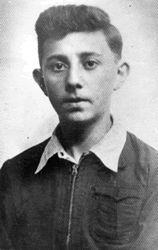 |
#B-246
Jurek Blones, member of the Bund and the Jewish underground in the Warsaw ghetto.
Catalog No.: 1069
Type of Item: Photo
Databank: Photo Archive
Jurek Blones, member of the Bund and the Jewish underground in the Warsaw (Warszawa) ghetto. Note: Blones was born in Warsaw in 1924. He was 15 years old at the outbreak of WWII, but despite his youth, he undertook underground missions of smuggling weapons into the ghetto. During the Warsaw ghetto ... |
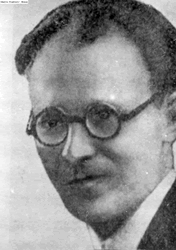 |
#B-247
Avraham Blum, "Abrasza", member of the Bund Central Committee and the Jewish Fighting Organization in the Warsaw ghetto.
Catalog No.: 1070
Type of Item: Photo
Databank: Photo Archive
Avraham Blum, "Abrasza", member of the Bund Central Committee and the Jewish Fighting Organization in the Warsaw (Warszawa) ghetto. Note: Blum was born in Vilnius (Vilna). In 1929 he moved to Warsaw, and from movement activities he soon became part of the party leadership. He was active in the Warsaw ... |
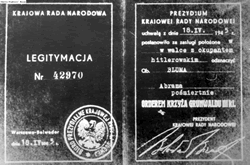 |
#B-248
Certificate for his activities fighting Nazis awarded posthumously to Avraham Blum (Abrasha), member of the Bund central committee and the Jewish Fighting Organization in the Warsaw ghetto.
Catalog No.: 1071
Type of Item: Photo
Databank: Photo Archive
Certificate for his activities fighting Nazis awarded posthumously to Avraham Blum (Abrasha), member of the Bund central committee and the Jewish Fighting Organization in the Warsaw (Warszawa) ghetto. This is for the Gruenwald Cross, Third Class. Blum also was awarded the Virtuti Militari, Fifth Class, ... |
 |
#B-249
Jakub Glattsztajn, a musician, voice teacher and conductor of the Bund's Tsukunft youth movement's children's choir during the German occupation.
Catalog No.: 1103
Type of Item: Photo
Databank: Photo Archive
Jakub Glattsztajn, a musician, voice teacher and conductor of the Bund's Tsukunft youth movement's children's choir during the German occupation. He took part in cultural activities in the Warsaw (Warszawa) ghetto and organized choral groups of refugee children. He composed the melody to Itzhak Katznelson's ... |
 |
#B-250
Leib - Levi Gruzalc, member of the Bund and the Jewish Fighting Organization in the Warsaw ghetto.
Catalog No.: 1107
Type of Item: Photo
Databank: Photo Archive
Leib - Levi Gruzalc, member of the Bund and the Jewish Fighting Organization in the Warsaw (Warszawa) ghetto. Note: Gruzalc was born in Warsaw. From an early age, he belonged to the Bund's Tsukunft youth movement. During the German occupation, he was active in finding safe houses for orphans and ... |
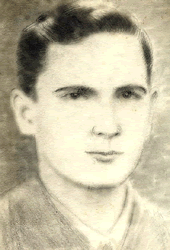 |
#B-251
A portrait of Leib - Levi Gruzalc, member of the Bund and the Jewish Fighting Organization in the Warsaw ghetto.
Catalog No.: 1108
Type of Item: Photo
Databank: Photo Archive
A portrait of Leib - Levi Gruzalc, member of the Bund and the Jewish Fighting Organization in the Warsaw (Warszawa) ghetto. For details about him, see Photo No. 1107. |
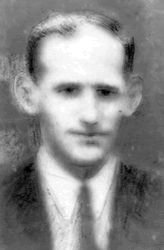 |
#B-252
Isra'el Grilek, member of the Bund and the Jewish Fighting Organization in the Warsaw ghetto.
Catalog No.: 1110
Type of Item: Photo
Databank: Photo Archive
Isra'el Grilek, member of the Bund and the Jewish Fighting Organization in the Warsaw (Warszawa) ghetto. Note: Grilek was born in Warsaw in 1910. During the Warsaw ghetto uprising in April 1943, he and his family were in the supply bunker at 30 Franciszkanska Street. After the bunker was destroyed, ... |
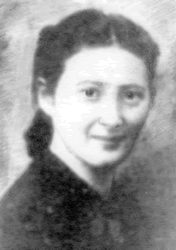 |
#B-253
Tova Dawidowic, member of the Bund and the Jewish underground in the Warsaw ghetto.
Catalog No.: 1116
Type of Item: Photo
Databank: Photo Archive
Tova Dawidowic, member of the Bund and the Jewish underground in the Warsaw (Warszawa) ghetto. Note: Tova Dawidowic was born in Warsaw on May 21, 1924. In February 1943, she took part with nine fighters of the Jewish Fighting Organization (ZOB) in a raid to expropriate money from the Judenrat bank ... |
 |
#B-254
David Hochberg, member of the Bund and the Jewish Fighting Organization in the Warsaw ghetto.
Catalog No.: 1119
Type of Item: Photo
Databank: Photo Archive
David Hochberg, member of the Bund and the Jewish Fighting Organization in the Warsaw (Warszawa) ghetto. Note: David Hochberg was born in 1925. During the Warsaw ghetto uprising in April 1943, he commanded one of the combat squads of the Bund. On April 27, 1943, he and his fighters were in the big ... |
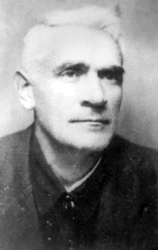 |
#B-255
Jakow - Ya'akov Wiernik, a participant in the uprising in the Treblinka extermination camp.
Catalog No.: 1146
Type of Item: Photo
Databank: Photo Archive
Jakow - Ya ' akov Wiernik, a participant in the uprising in the Treblinka extermination camp. Photographed in August 1943. Biographic notes: Jakow - Jankiel Wiernik was born in 1887 in the Brisk district, now Brest, Belarus. In 1904 he was among the defenders in the Jewish Labor Bundmovement. ... |
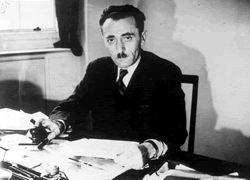 |
#B-256
Shmuel - Artur Zygelbojm, a leader of the Bund in Poland.
Catalog No.: 1149
Type of Item: Photo
Databank: Photo Archive
Shmuel - Mordechai Artur Zygelbojm, a leader of the Bund in Poland. Note: Zygelbojm was born in 1893. In March 1942, he went from Warsaw (Warszawa) to London and joined the second Polish National Council of the Polish government - in - exile there. On May 12, 1943, he committed suicide at the gate ... |
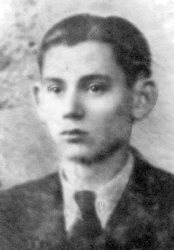 |
#B-257
Adam - Adek Jankelewic, member of the Bund and the Jewish Fighting Organization in the Warsaw ghetto.
Catalog No.: 1167
Type of Item: Photo
Databank: Photo Archive
Adam - Adek Jankelewic, member of the Bund and the Jewish Fighting Organization in the Warsaw (Warszawa) ghetto. Note: Jankelewic was born in Warsaw. During the Warsaw ghetto uprising of April 1943, he fought in a Bund combat squad. On suppression of the uprising, he and his comrades escaped the ... |
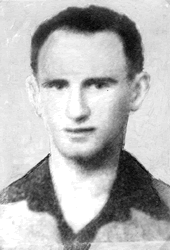 |
#B-258
Shimon Malinowski, member of the Bund and the Jewish Fighting Organization in the Warsaw ghetto.
Catalog No.: 1194
Type of Item: Photo
Databank: Photo Archive
Shimon Malinowski, member of the Bund and the Jewish Fighting Organization (ZOB) in the Warsaw (Warszawa) ghetto. Note: Malinowski was born in Lodz in 1910. He was deported to the Trawniki camp, where he commanded an underground cell and organized a workshop for repairing weapons. He perished in ... |
 |
#B-259
Wladka and Benjamin Miedzyrzecki - Meed, members of the Bund and the Jewish underground in Warsaw.
Catalog No.: 1201
Type of Item: Photo
Databank: Photo Archive
Wladka and Benjamin Miedzyrzecki - Meed, members of the Bund and the Jewish underground in Warsaw (Warszawa). Photographed in Lodz in January 1945. For details about Wladka Meed (Feygl Peltel), see Photo No. 1265. Note: Wladka and Benjamin Meed survived the Holocaust, and live today in the United ... |
 |
#B-260
Sonia Nowogrodski - Czemelynski, member of the Bund and the Jewish Fighting Organization in the Warsaw ghetto.
Catalog No.: 1210
Type of Item: Photo
Databank: Photo Archive
Sonia Nowogrodski - Czemelynski, member of the Bund and the Jewish Fighting Organization (ZOB) in the Warsaw (Warszawa) ghetto. Note: During the Great Aktion (mass deportations) in the Warsaw ghetto, on August 13, 1942 she was sent to the Majdanek extermination camp, where she perished. |
 |
#B-261
Chancza Papier and Chana Frysdorf, members of the Bund and the Jewish Fighting Organization in the Warsaw ghetto.
Catalog No.: 1227
Type of Item: Photo
Databank: Photo Archive
Chancza Papier and Chana Frysdorf, members of the Bund and the Jewish Fighting Organization (ZOB) in the Warsaw (Warszawa) ghetto. Photographed in 1941. Notes: Chana Frysdorf fought in the Warsaw ghetto uprising in April 1943. On the suppression of the uprising, she and her husband Gabriel went ... |
 |
#B-262
Renia Pizszic, member of the Bund and the Jewish Fighting Organization in the Warsaw ghetto.
Catalog No.: 1245
Type of Item: Photo
Databank: Photo Archive
Renia Pizszic, member of the Bund and the Jewish Fighting Organization (ZOB) in the Warsaw (Warszawa) ghetto. Note: Renia Pizszic was born in Warsaw in October 1901. She fell in the Warsaw ghetto uprising on May 10, 1943, in the air - raid shelter of the hospital where she worked, at 6 Gesia Stre ... |
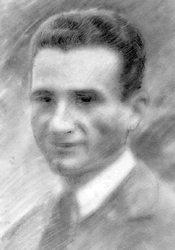 |
#B-263
Avraham Feiner, member of the Bund and the Jewish Fighting Organization in the Warsaw ghetto.
Catalog No.: 1247
Type of Item: Photo
Databank: Photo Archive
Avraham Feiner, member of the Bund and the Jewish Fighting Organization in the Warsaw (Warszawa) ghetto. Note: Avraham Feiner was born in Warsaw in 1915. Before the war he served on the Warsaw committee of the Bund's youth movement, Tsukunft. At the outbreak of WWII he fought in the Polish army, ... |
 |
#B-264
Dr. Leon Feiner, a key activist of the Bund and a leader in the Jewish Fighting Organization in the Warsaw ghetto.
Catalog No.: 1248
Type of Item: Photo
Databank: Photo Archive
Dr. Leon Feiner, a key activist of the Bund and a leader in the Jewish Fighting Organization (ZOB) in the Warsaw (Warszawa) ghetto. Note: Leon Feiner (known in the underground by the names "Mikolaj" and "Barzowski") was born in Krakow in 1886. He was chairman of the Bund's Central Committee. He ... |
 |
#B-265
Salo - Henryk Fiszgrund, member of the Bund and the Jewish underground in the Warsaw ghetto.
Catalog No.: 1252
Type of Item: Photo
Databank: Photo Archive
Salo - Henryk Fiszgrund, member of the Bund and the Jewish underground in the Warsaw (Warszawa) ghetto. Note: Fiszgrund was born in the city of Selo. He was a member of the underground's Coordination Committee in Warsaw. Among his various activities, he was the head of a secret cell for rescuing ... |
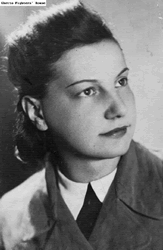 |
#B-266
Wladka Miedzyrzecki - Meed (Feygl Peltel), member of the Bund and a courier for the Jewish Fighting Organization in the Warsaw ghetto.
Catalog No.: 1265
Type of Item: Photo
Databank: Photo Archive
Wladka Miedzyrzecki - Meed (Feygl Peltel), member of the Bund and a courier for the Jewish Fighting Organization (ZOB) in the Warsaw (Warszawa) ghetto. Note: Wladka Meed was born in Warsaw; her name was originally Feygl Peltel. Her "Aryan" appearance and fluent knowledge of Polish allowed her to ... |
 |
#B-267
The false "Aryan" identity document of Feygl Peltel (Wladka Miedzryzecki - Meed), member of the Bundand a courier for the Jewish Fighting Organization in the Warsaw ghetto.
Catalog No.: 1266
Type of Item: Photo
Databank: Photo Archive
The false "Aryan" identity document of Feygl Peltel (Wladka Miedzryzecki - Meed), member of the Bund and a courier for the Jewish Fighting Organization (ZOB) in the Warsaw (Warszawa) ghetto. The document was issued on Nov. 27, 1943. See details about her in Photo No. 1265. |
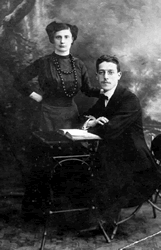 |
#B-268
The parents of Feygl Peltel (Wladka Miedzyrzecki - Meed), member of the Bund and a courier for the Jewish Fighting Organization in the Warsaw ghetto.
Catalog No.: 1268
Type of Item: Photo
Databank: Photo Archive
The parents of Feygl Peltel (Wladka Miedzyrzecki - Meed), member of the Bund and a courier for the Jewish Fighting Organization (ZOB) in the Warsaw (Warszawa) ghetto. For details about her see Photo No. 1265. |
 |
#B-269
Zalman - Zygmunt Friedrich, member of the Bund and the Jewish Fighting Organization in the Warsaw ghetto.
Catalog No.: 1277
Type of Item: Photo
Databank: Photo Archive
Zalman - Zygmunt Friedrich, member of the Bund and the Jewish Fighting Organization (ZOB) in the Warsaw (Warszawa) ghetto. Photographed on July 1, 1937. Note: Friedrich was born in Warsaw in 1911. With the outbreak of WWII he was drafted into the Polish army, fought the Germans and fell prisoner. ... |
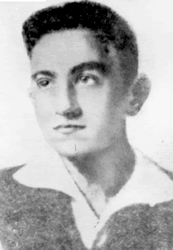 |
#B-270
Michael Kleppfisch, member of the Bund and the Jewish Fighting Organization in the Warsaw ghetto.
Catalog No.: 1283
Type of Item: Photo
Databank: Photo Archive
Michael Kleppfisch, member of the Bund and the Jewish Fighting Organization (ZOB) in the Warsaw (Warszawa) ghetto. Note: Michael Kleppfisch was born in Warsaw. An airplane mechanic by profession and with technical skills, he worked on producing weapons in an underground workshop. He also dealt with ... |
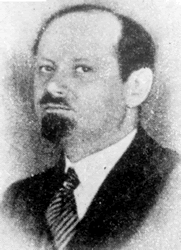 |
#B-271
Menachem Kirschenbaum, a leader of the General Zionists, public activist and member of the Jewish underground in the Warsaw ghetto.
Catalog No.: 1299
Type of Item: Photo
Databank: Photo Archive
Menachem Kirschenbaum, a leader of the General Zionists, community activist and member of the Jewish underground in the Warsaw (Warszawa) ghetto. Note: Kirschenbaum was born in Lublin. He was one of the founders of Tekumah (Hebrew: Revival; the organization for promoting the Hebrew language) together ... |
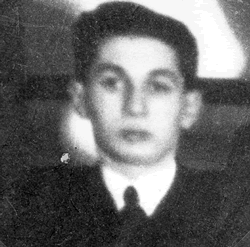 |
#B-272
Wolf - Welwel Rozowski, member of the Bund and the Jewish Fighting Organization in the Warsaw ghetto.
Catalog No.: 1313
Type of Item: Photo
Databank: Photo Archive
Wolf - Welwel Rozowski, member of the Bund and the Jewish Fighting Organization (ZOB) in the Warsaw (Warszawa) ghetto. Note: Wolf Rozowski was born in 1916, evidently in Stolbtsy. During the Warsaw ghetto uprising of April 1943 he commanded a combat squad that fought in the Toebbens - Schultz area. ... |
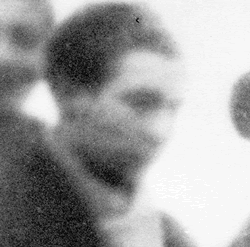 |
#B-273
Wolf - Welwel Rozowski, member of the Bund and the Jewish Fighting Organization in the Warsaw ghetto.
Catalog No.: 1314
Type of Item: Photo
Databank: Photo Archive
Wolf - Welwel Rozowski, member of the Bund and the Jewish Fighting Organization (ZOB) in the Warsaw (Warszawa) ghetto. See details about him in Photo No. 1313. |
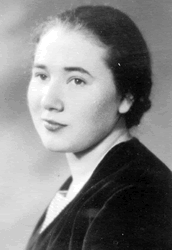 |
#B-274
Adina Schweiger - Baldi, code name "Inka," member of the Jewish underground in the Warsaw ghetto.
Catalog No.: 1324
Type of Item: Photo
Databank: Photo Archive
Adina Schweiger - Baldi, code name "Inka," member of the Jewish underground in the Warsaw (Warszawa) ghetto. Photographed in 1934 on receiving her high school diploma. Note: Inka Schweiger was born in Warsaw in 1917. She worked as a physician in the ghetto hospital, and was a courier for the Bund ... |
 |
#B-275
Adina Schweiger - Baldi, member of the Jewish underground in the Warsaw ghetto.
Catalog No.: 1325
Type of Item: Photo
Databank: Photo Archive
Adina Schweiger - Baldi, member of the Jewish underground in the Warsaw (Warszawa) ghetto. Photographed with her daughter, born at the end of the war. For details about Adina "Inka" Schweiger, see Photo No. 1324. |
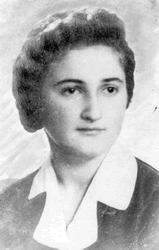 |
#B-276
Leah Szifman, member of the Bund and the Jewish Fighting Organization in the Warsaw ghetto.
Catalog No.: 1326
Type of Item: Photo
Databank: Photo Archive
Leah Szifman, member of the Bund and the Jewish Fighting Organization (ZOB) in the Warsaw (Warszawa) ghetto. Note: Leah Szifman was born in Warsaw in 1922. During the Warsaw ghetto uprising in April 1943, she fought in the combat squad commanded by Leib Gruzalc. On April 24, 1943, the air - raid ... |
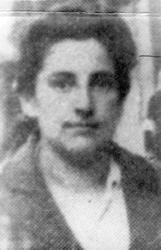 |
#B-277
Miriam Szifman, member of the Bund and the Jewish Fighting Organization in the Warsaw ghetto.
Catalog No.: 1327
Type of Item: Photo
Databank: Photo Archive
Miriam Szifman, member of the Bund and the Jewish Fighting Organization (ZOB) in the Warsaw (Warszawa) ghetto. Note: Miriam Szifman was born in Warsaw in 1916. She belonged to Tsukunft, the Bund's youth movement, and after the outbreak of WWII served as head of the party's Warsaw branch. She would ... |
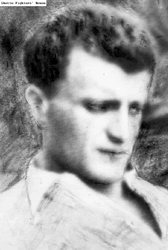 |
#B-278
Avraham - Shmuel "Berek" Schneidemil, Bund activist and member of the Jewish Fighting Organization in the Warsaw ghetto.
Catalog No.: 1336
Type of Item: Photo
Databank: Photo Archive
Avraham - Shmuel "Berek" Schneidemil, Bund activist and member of the Jewish Fighting Organization (ZOB) in the Warsaw (Warszawa) ghetto. Note: Berek Schneidemil was born in Lodz in 1903. At an early age he moved to Warsaw and joined Tsukunft, the Bund's youth movement. With the outbreak of WWII ... |
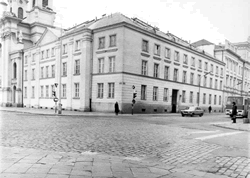 |
#B-279
The building at No. 24 Miodowa Street on the "Aryan" side of Warsaw.
Catalog No.: 1351
Type of Item: Photo
Databank: Photo Archive
The building at No.24 Miodowa Street on the "Aryan" side of Warsaw (Warszawa). Bund activist Bracha - Bronka Feinmesser of the Jewish Fighting Organization (ZOB) rented an apartment here to serve as a hideout for fighters who escaped from the ghetto. See: Rotem, Simcha (Kazik), "Memoirs of a Warsaw ... |
 |
#B-280
The building at No. 2 Barokowa Street on the "Aryan" side of Warsaw.
Catalog No.: 1357
Type of Item: Photo
Databank: Photo Archive
The building at No. 2 Barokowa Street on the "Aryan" side of Warsaw (Warszawa). In this building was an apartment which served as a hiding place for Jews, rented by , a courier - liaison for the Jewish Fighting Organization (ZOB) in the Warsaw ghetto. The fighters Zalman Friedrich and Simcha Rathajzer ...
• |
 |
#B-281
The building at No. 41 or No. 43 Promyka Street on the "Aryan" side of Warsaw, whose cellar was a hideout for ZOB fighters after the Polish uprising of 1944.
Catalog No.: 1358
Type of Item: Photo
Databank: Photo Archive
The building at No. 41 or No. 43 Promyka Street on the "Aryan" side of Warsaw (Warszawa), whose cellar was a hideout for Jewish Fighting Organization (ZOB) fighters after the Polish uprising of 1944. Note: Some members of the Jewish Fighting Organization who had survived after the suppression of the ... |
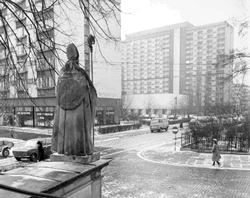 |
#B-282
A view of Chlodna Street in Warsaw.
Catalog No.: 1360
Type of Item: Photo
Databank: Photo Archive
A view of Chlodna Street in Warsaw (Warszawa). Note: During the war, the Bundist and Jewish Fighting Organization (ZOB) member David Klin had a clandestine apartment at No. 17 Chlodna Street. After underground activities spread out in the ghetto, Klin moved to the "Aryan" side of the city, where ... |
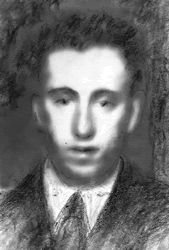 |
#B-283
Leib Karsh, member of the Bund and the Jewish Fighting Organization in the Warsaw ghetto.
Catalog No.: 1853
Type of Item: Photo
Databank: Photo Archive
Leib Karsh, member of the Bund and the Jewish Fighting Organization (ZOB) in the Warsaw (Warszawa) ghetto. Note: Karsh was born in Goworowo. During the Warsaw ghetto uprising he was in the shelter at 30 Franciszkanska Street. He fell at the hospital at 6 Gesia Street. |
| |
#B-284 |
| The Bundists |
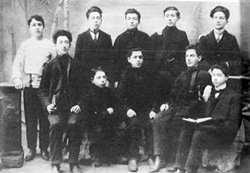 |
#BT-001
1905
Vilna
Studio portrait: "A group of young [Jewish Socialist] Bundists from Lodz... standing 2nd from right is Yankev Dovid Berg... now president of the Sholem Aleichem Institute in N. Y. Seated, 2nd from left is his brother Avrom" ('Forward' spread, 1937). |
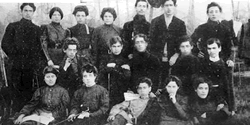 |
#BT-002
1905
Liepaja
Outdoor portrait of a group of young Jewish Socialist Bundists, some holding copies of the 'Folkstsaytung' (People's News). (From a 'Jewish Daily Forward' spread, 1937: "Jewish Revolutionaries Of The Past.") |
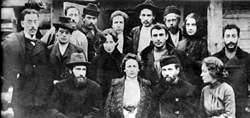 |
#BT-003
1906
Siberia
Group portrait in front of a log building: "[Unidentified] Jewish revolutionaries of the past. A rare picture of a group of [Jewish Socialist] Bundists... Some of them were quite prominent in the movement at that time." ('Jewish Daily Forward', 1937.) |
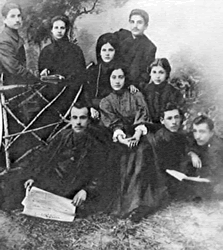 |
#BT-004
1906
Kanetap
Studio portrait of young men and women: "A group of [Jewish Socialist] Bundists... Sitting 2nd from right is H. Jacobson, now in Philadelphia." (Yiddish caption. From a photo essay in the "Forward," 1929: "Revolutionary Workers Of The Past.") |
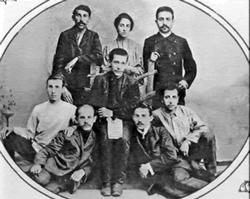 |
#BT-005
1905
Berdichev
Studio portrait: "A group of Bundists from Brisk, Bialystok, Dvinsk, and other cities... (The youth in the center is Avreml Bialystoker.)" (Caption from a photo essay in the "Jewish Daily Forward," 1929: "Revolutionary Workers Of The Past.") |
 |
#BT-006
1903
Pinsk
Ilivicki & W.
Studio portrait of H. Silverman (standing, right), M. Weitzman and three other young Jewish Socialist Bundists. |
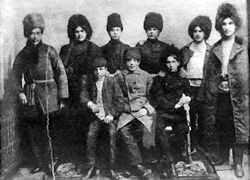 |
#BT-007
1905
Eastern Europe
Studio portrait in Cossack-style fur hats: "A group of Social-Democrats and [Jewish Socialist] Bundists who were exiled to Siberia... Some are from Bialystok, some from Pinsk, and one is from Sieradz..." ('Forward' photo essay on revolutionaries, 1931). |
 |
#BT-008
1905
Rovno
"Bundists of 20 years ago. Interesting Russian-Jewish types of the [Jewish Socialist] Bund... Second from right [standing] is D. Shier, our 'Forward' representative in Minneapolis." ("Jewish Daily Forward" Yiddish caption.) |
 |
#BT-009
1904
Vilna
Studio portrait of "Vilna [Jewish Socialist] Bundists. These Vilna tailors were active in the revolutionary movement..." ('Jewish Daily Forward' caption in English.) |
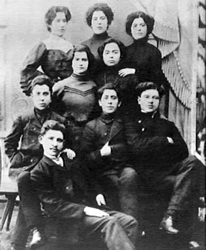 |
#BT-010
pub. Sept. 19, 1926
Russia
"Some of the heroic men and women who risked their lives fighting Tsarism." "[Jewish Socialist] Bundists of yesteryear... They are now in America and are members of the Socialist 'Farband' [Union]. (2nd row, left is member Asher)." ("Forward.") |
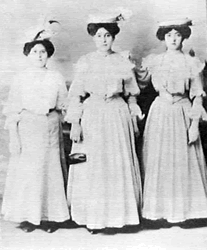 |
#BT-011
1904
Vitebsk
Studio portrait of a group of [Jewish Socialist] Bundists, young men and women. (Part of a photo essay in the 'Jewish Daily Forward', 1927: "Bundist Men And Women Of The Past.") |
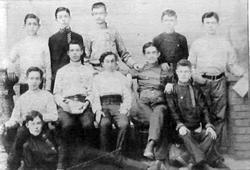 |
#BT-012
1904
Ostrow
Studio portrait of [Jewish Socialist] Bundists. |
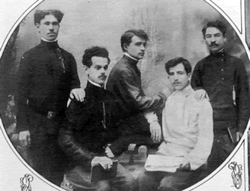 |
#BT-013
1903
Mogilev
A group of (Jewish Socialist) Bundists, five young men posing for a studio portrait, each with a hand on another's shoulder. (Part of a photo essay in the 'Jewish Daily Forward', 1928: "Jewish Revolutionary Groups Of The Past.") |
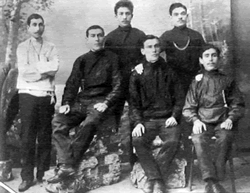 |
#BT-014
1904
Daugavpils
Six young men: "United by one ideal". Studio portrait of a group of (Jewish Socialist) Bundists. (Part of a photo essay in the 'Jewish Daily Forward', 1928: "Revolutionaries Of The Past.") |
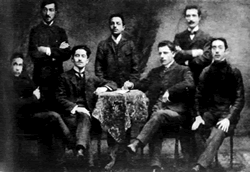 |
#BT-015
1905
Lublin
Studio portrait of six well-dressed men, "a group of [Jewish Socialist] Bundists". (Part of a 'Jewish Daily Forward' photo essay, 1932: "Jewish Revolutionaries Of The Past... Submitted By Our Readers.") |
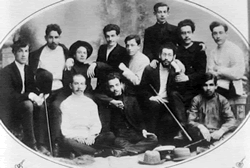 |
#BT-016
1906
Mogilev
Studio portrait: "United by one ideal. A group of active [Jewish Socialist] Bundists..." "Submitted by Yerakhmiel Gurevits, one of the group, now living in Wooster, Massachusetts." ('Forward' photo essay, 1933: "Jewish Revolutionaries Of The Past...") |
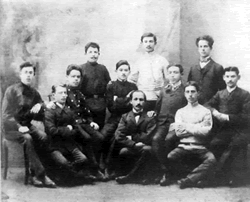 |
#BT-017
1904
Pinsk
Studio portrait: "Pinsk [Jewish Socialist] Bundists... 2 of them now in Chicago and members of the Pinsker Branch 252 Workmen's Circle. They are Joe Kaplan (front row, 2nd from right) and Charlie Siegel (left)." (From a 'Forward' photo essay, 1933.) |
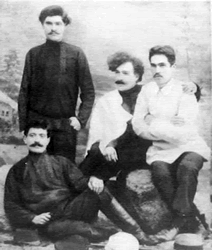 |
#BT-018
1904
Liozno
Studio portrait: "'Alter the shoemaker', 'Avreml the shoemaker', H. Landishman, and M. Slevin -- [Jewish Socialist] Bundists... Slevin (the first from right) is now located in New York." (From a 'Forward' spread, 1933: "Jewish Revolutionaries...") |
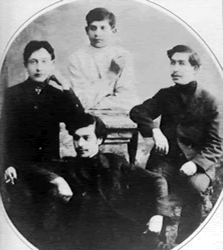 |
#BT-019
1906
Gorkiy
Studio portrait of "active [Jewish Socialist] Bundists..." (Part of a 'Jewish Daily Forward' photo spread, 1933: "Jewish Revolutionaries Of The Past.") |
 |
#BT-020
1913
Bialystok
Labor Zionists, Jewish Socialist Bundists, Polish Socialist Party members. (Front, r-l): Tsalkov, Halpern, Polonski, Rafalovski, Shpiner; (back) Dovidovitsh, Pitkovski, Pripshteyn, Kushner, Melovitski, Bapkes. ('Forward': "Jewish Revolutionaries...") |
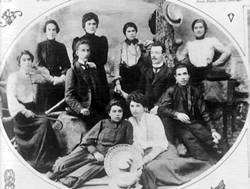 |
#BT-021
1910
Vilna
Studio portrait: "A group of men and woman Bundists... Also in the group are several members of the PPS [Polish Socialist Party]." (From a 'Jewish Daily Forward' spread, 1934: "Jewish Revolutionaries Of The Past -- Submitted By Our Readers.") |
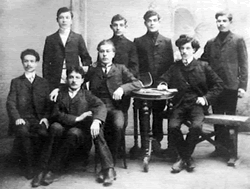 |
#BT-022
1904
Vitebsk
Studio portrait of a group of young men, (hands on each other's shoulders): "...Vitebsker [Jewish Socialist] Bundists... This picture was sent in by Mrs. M. Rotrik, of the Bronx." (From a "Forward' spread, 1934: "Jewish Revolutionaries Of The Past.") |
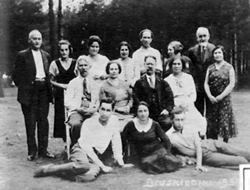 |
#BT-023
pub. Sept. 23, 1934
Druskininkay
"A group of prominent [Jewish Socialist] Bundists at a get-together in... a health resort... In the back row are Henryk Erlich (right) and Vladimir Kossovsky [Kosovsky] (left). In the middle row is Arkadi Kremer (2nd from right)." ("Forward" Yiddish caption.) |
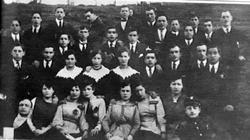 |
#BT-024
1920
Stopnica
Formal portrait on a field: "A group of [Jewish Socialist] Bundists, young men and women, on a picnic... Many of them are now live in America." (From a "Forward' photo spread, 1935: "Jewish Revolutionaries Of The Past -- Submitted By Our Readers.") |
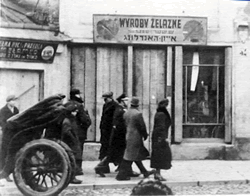 |
#BT-025
pub. April 26, 1936
Vilna
On 'Zavalne' Street: "Arrested for participating in the strike. ...2 [Jewish Socialist] Bundists... being led to the police station." ('Forward' spread: "Jewish Streets Of Vilna During The Recent Protest Strike Against Persecutions Of Jews In Poland.") |
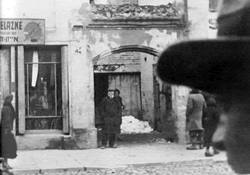 |
#BT-026 |
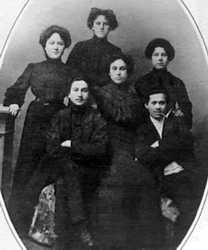 |
#BT-027
1905
Siauliai
Studio portrait of "a group of men and women [Jewish Socialist] Bundists... The girl standing center is now Mrs. Minnie Rogowsky, of Brooklyn. In the old country she called herself Mikhlye -- Mikhlye Kesl." ('Forward' spread on revolutionaries, 1936.) |
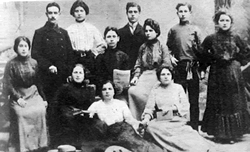 |
#BT-028
Early 1900's
Kaunas
Studio portrait: "Young men and women [Jewish Socialist] Bundists... The woman on the left, center row [under X] then went by the name of Esther Kaplan (her maiden name), now Mrs. Lipoy of the Bronx." ('Forward' spread on revolutionaries, 1936.) |
 |
#BT-029
1904
Bobruisk
Portrait of Bundists: (seated, l to r) Beni Lazinski, Nakhke Yokheved, Brokhe Ginzburg, Noyekh Kazanovitsh, Tsirl Yabrov, Artshe Harelikh; (standing) Nekhome-Sore Kazanovitsh, Avrom Kurzhniki, Yazhe Ginzburg, Elye Grayfer, Hirsh Yokheved, Ida Harelikh. |
 |
#BT-030
1920
Telsiai
Outdoor group portrait of men and women (some of them [Jewish Socialist] Bundists), and (l) a child: (center, with pnce-nez) teacher Sheve Raivits; (to her left) teacher Rivke Yafe. "A group of intellectuals..." (written in Yiddish).
|
| |
#BT-031
1904
Daugavpils
Studio portrait of a group of [Jewish Socialist] Bundists, young women, all wearing the same style dress, some holding literature. (Part of a photo essay in the 'Jewish Daily Forward', 1927: "Bundist Men And Women Of The Past.") |
HeHalutz or Hechalutz (lit. The Pioneer) was a Jewish youth movement that trained young people for agricultural settlement in the Land of Israel. It became an umbrella organization of the pioneering Zionist youth movements.
History
HeHalutz was founded by Eliezer Joffe in America in 1905, and about the same time in Russia.[1]
During World War I, HeHalutz branches opened across Europe (including Russia), America and Canada. Leaders of the organization included Yitzhak Ben-Zvi (later the second president of the State of Israel), and David Ben-Gurion (later the first Prime Minister of Israel) in America, and Joseph Trumpeldor in Russia.
Ben-Gurion was living in Jerusalem at the start of the First World War, where he and Ben Zvi recruited forty Jews into a Jewish militia to assist the Ottoman army. Despite this, he was deported to Egypt in March 1915. From there he made his way to the United States, where he remained for three years. On his arrival, he and Ben Zvi went on a tour of 35 cities in an attempt to raise a Hechalutz "pioneer army" of 10,000 men to fight on Turkey's side.[2] After the Balfour Declaration of November 1917, the situation changed dramatically and Ben-Gurion, with the interest of Zionism in mind, switched sides and joined the newly formed Jewish Legion of the British Army, leaving to fight the Turks in Palestine.
At its peak, between 1930 and 1935, HeHalutz operated in 25 countries throughout Europe, North Africa, the Middle East, and Northern South America. In 1932-1934, Golda Meir, later the prime minister of Israel, was the secretary of the women's chapter of HeHalutz in the United States.[3]
In 1932, the organization established headquarters in New York and twenty branches in cities and towns throughout the United States and Canada. Farms were then established to train members for agricultural work in Palestine. Such farms operated in Creamridge, New Jersey, Heightstown, New Jersey, Poughkeepsie, New York, Smithville, Ontario., and Colton, California.[4]
In 1933, after Jews were expelled from the workforce in Nazi Germany, HeHalutz farms became the primary framework for vocational training and preparation for emigration.[5]
By the eve of Second World War in 1939, HeHalutz numbered 100,000 members worldwide, with approximately 60,000 having already emigrated (aliyah) to Mandate Palestine, and with 16,000 members in training centers (hakhsharot) for the pioneering life in the Land of Israel.[6] During the war and German occupation, Jews in some ghettos in Europe established Hechalutz units, as in Lithuania's Šiauliai Ghetto.[7] By the 1950's HeHalutz"... was absorbed by Hashomer Hatzair, which had always maintained a large degree of autonomy. Nominally, however, the He-?alutz Organization of America still exists...."[8]
References
1 ^ Ritov, Israel; Slutsky, Yehuda (2007). "He-?alutz". In Michael Berenbaum and Fred Skolnik. Encyclopaedia Judaica. 8 (2 ed.). Detroit: Macmillan Reference USA. pp. 756–761.
2 ^ Teveth, Shabtai (1985) Ben-Gurion and the Palestinian Arabs. From Peace to War. Oxford University Press. ISBN 0-19-503562-3. pp. 25, 26.
3 ^ Golda Meir
4 ^ Jewish Virtual Library: HeHalutz
5 ^ Before Catastrophe: The Distinctive Path of German Zionism, Hagit Lavsky
6 ^ Resistance in the Smaller Ghettos of Eastern Europe United States Holocaust Memorial Museum
7 ^ "The Shavli Ghetto". Association of Lithuanian Jews in Israel. Retrieved 27 April 2012.
8 ^ Jewish Virtual Library: HeHalutz |
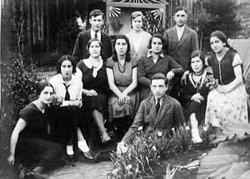 |
#H-001
1932
Ciechanow
Members of Hehalutz Hatzair (Young Pioneer), a Zionist youth group, pose in a garden. |
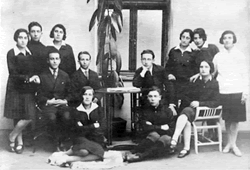 |
#H-002
1933
Ciechanow
Studio portrait of members of Hehalutz Hatzair (Young Pioneer), a Zionist youth group. |
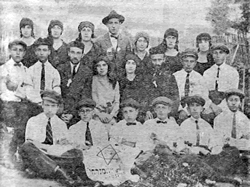 |
#H-003
Czestochowa
Portrait of members of the Hehalutz Hamizrachi farm, an agricultural training farm for a religious Zionist organization. |
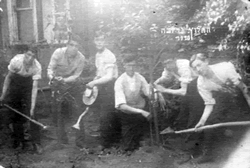 |
#H-004
1920
Grayevo
Members of Hehalutz (Pioneer), a pioneering Zionist youth movement, pose at work planting trees. |
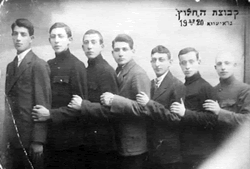 |
#H-005
1920
Grayevo
Members of Hehalutz (Pioneer), a pioneering Zionist youth movement, pose for a portrait in order of size. |
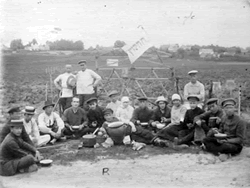 |
#H-006
1920
Grodno
Members of the Hehalutz agricultural group (Hebrew name on banner) at a meal by a field. A portrait of Theodor Herzl rests on a hoe leaning on a gate made of two wooden Stars of David. The sign above reads in Polish and Yiddish "No Thoroughfare." |
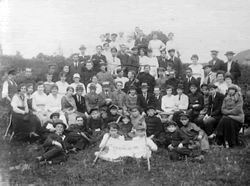 |
#H-007
1920
Grodno
Members of the Hehalutz agricultural group (Hebrew name on banner) posing in a field. |
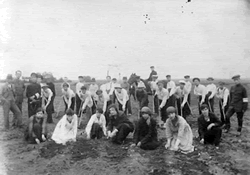 |
#H-008
1920
Grodno
Members of the Hehalutz agricultural group (Hebrew name on banner) posing at work in a field. |
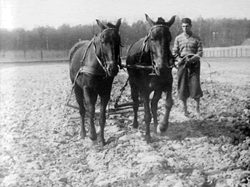 |
#H-009
1920s-30s
Lvov
On the Jewicz farm in the Sygniowka suburb, used as a training farm by the Hehalutz (Pioneer) Zionist youth movement: young man working a horse-drawn plow. |
 |
#H-010
1920s-30s
Lvov
At the Jewicz farm in the Sygniowka suburb, used as a training farm by the Hehalutz (Pioneer) Zionist youth movement: two men with horses at work in a field. |
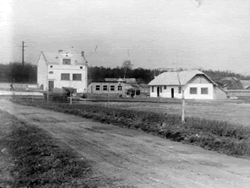 |
#H-011
Lvov
A view of the Jewicz farm in the Sygniowka suburb, used as a training farm by the Hehalutz (Pioneer) Zionist youth movement. (Left) a building entitled "House of Friendship." |
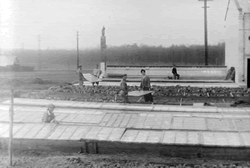 |
#H-012
Lvov
At the Jewicz farm in the Sygniowka suburb, used as a training farm by the Hehalutz (Pioneer) Zionist youth movement: young people carrying window sashes by the greenhouses. |
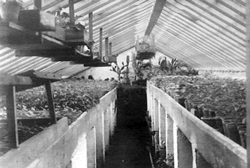 |
#H-013
Lvov
Interior of the greenhouse at the Jewicz farm in the Sygniowka suburb, used as a training farm by the Hehalutz (Pioneer) Zionist youth movement. |
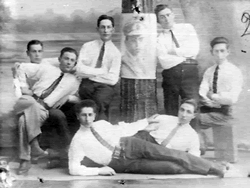 |
#H-014
1919
Mlawa
Studio portrait of members of Hehalutz Hatzair, a Zionist youth group, with a portrait of Vladimir (Ze'ev)Jabotinsky. |
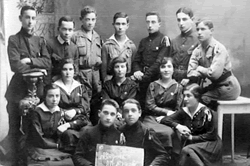 |
#H-015
1919 and 1925
Mlawa
Members of the Zionist Hehalutz Hatzair.
|
 |
#H-016
August 15, 1925
Mlawa
Studio portrait of members of the Zionist Hehalutz Hatzair (Young Pioneer) work group. |
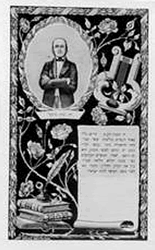 |
#H-017
After 1848
Stanislawow
Postcard: Dr. Isaac Erter (1791-1851), a satiric writer of the Jewish Enlightenment and editor of 'HeHalutz' (The Pioneer). The harp, the feather pen, inkwell and the weighty tomes were symbols conventionally used on postcards featuring writers. |
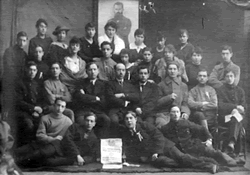 |
#H-018
1923
Daugavpils
Group portrait of members of the Zeirei Zion and Hehalutz Zionist youth organizations: young men and women (some wearing ribbons) with a Hebrew-Yiddish poster in front of a portrait of Herzl. (2nd row, seated, 2nd from left) Moshe Amir-Bliakh. |
| Hechalutz |
 |
#H-019
The concluding ceremony of a joint seminar of the He - Chaluts ha - Tsa'ir and Freiheit youth movements, held in The concluding ceremony of a joint seminar of the He - Chaluts ha - Tsa'ir and Freiheit youth movements, held in Warsaw.
Catalog No.: 37
Type of Item: Photo
Databank: Youth Movements Photos
The concluding session of a joint seminar of the He - Chaluts ha - Tsa'ir and Freiheit youth movements, held in Warsaw (Warszawa). Photographed in January 1931. |
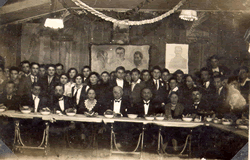 |
#H-020
The concluding session of a joint seminar of the He - Chaluts ha - Tsa'ir and Freiheit youth movements, held in Warsaw.
Catalog No.: 49
Type of Item: Photo
Databank: Youth Movements Photos
The concluding session of a joint seminar of the He - Chaluts ha - Tsa'ir and Freiheit youth movements, held in Warsaw (Warszawa). Photographed in 1931. |
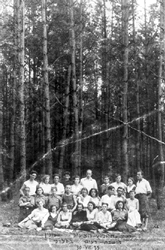 |
#H-021
A summer camp of the He - Chaluts ha - Tsa'ir youth movement in Zelenaya (Zielona).
Catalog No.: 153
Type of Item: Photo
Databank: Youth Movements Photos
A summer camp of the He - Chaluts ha - Tsa'ir youth movement in Zelenaya (Zielona). Among the participants: the emissary from Palestine, Pinchas Rashish. Photographed on July 30, 1933. |
 |
#H-022
A training program for older members of the He - Chaluts ha - Tsa'ir youth movement, held in Horodlec.
Catalog No.: 157
Type of Item: Photo
Databank: Youth Movements Photos
The senior members at a camp session of the He - Chaluts ha - Tsa'ir youth movement, held in Horodlec [spelling of place name unconfirmed]. Photographed on June 11, 1936. |
 |
#H-023
A summer camp of the He - Chaluts ha - Tsa'ir youth movement in the Bialystok region.
Catalog No.: 158
Type of Item: Photo
Databank: Youth Movements Photos
A summer camp of the He - Chaluts ha - Tsa'ir youth movement in the Bialystok region. Photographed between the two world wars. |
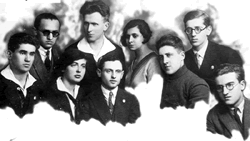 |
#H-024
Activists of the He - Chaluts organization central and the He - Chaluts ha - Tsa'ir youth movement in Warsaw.
Catalog No.: 306
Type of Item: Photo
Databank: Youth Movements Photos
Activists of the He - Chaluts organization central and the He - Chaluts ha - Tsa'ir youth movement in Warsaw (Warszawa). In the photo: Fania Bergstein (bottom row, second from the left) and Pinchas Lander - Elad (top row, second from the left). Photographed in 1927 or 1928. |
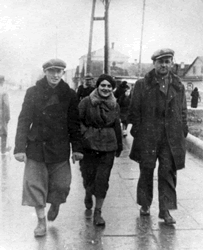 |
#H-025
Activists of the He - Chaluts ha - Tsa'ir youth movement in Lutsk in 1936.
Catalog No.: 327
Type of Item: Photo
Databank: Youth Movements Photos
Activists of the He - Chaluts ha - Tsa'ir youth movement in Lutsk in 1936. In the photo: Berger (on the right), Sheinda'leh (surname unknown, center), and Zalman (surname unknown, left). |
 |
#H-026
Yakov Naumark, representative of the Freiheit youth movement on the He - Chaluts movement's Central Committee in Lvov, with three youth counselors from the He - Chaluts ha - Tsa'ir youth movement branch in Mielec.
Catalog No.: 344
Type of Item: Photo
Databank: Youth Movements Photos
Yakov Naumark, representative of the Freiheit youth movement on the He - Chaluts movement's Central Committee in Lvov, with three youth counselors from the He - Chaluts ha - Tsa'ir youth movement branch in Mielec. Photographed in 1933. |
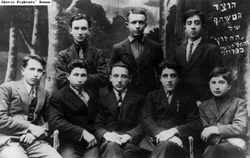 |
#H-027
The combined committee of the He - Chaluts organization and He - Chaluts ha - Tsa'ir youth movement in Pruzhany.
Catalog No.: 399
Type of Item: Photo
Databank: Youth Movements Photos
The combined committee of the He - Chaluts organization and He - Chaluts ha - Tsa'ir youth movement in Pruzhany. |
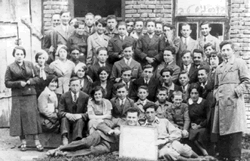 |
#H-028
Members of the Zionist organization He - Chaluts and the youth movement He - Chaluts ha - Tsa'ir in Krasnystaw
Catalog No.: 451
Type of Item: Photo
Databank: Youth Movements Photos
Members of the Zionist organization He - Chaluts and the youth movement He - Chaluts ha - Tsa'ir in Krasnystaw. Photographed in 1932 or 1933. |
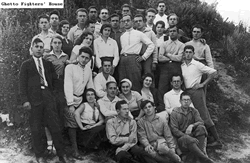 |
#H-029
Members of the He - Chaluts association of youth movements and the Ha - Shomer ha - Tsa'ir youth movement in Vileyka, prior to the emigration to Palestine of members of the "Ha - Sansanim" group.
Catalog No.: 706
Type of Item: Photo
Databank: Youth Movements Photos
Members of the He - Chaluts association of youth movements and the Ha - Shomer ha - Tsa'ir youth movement in Vileyka, prior to the emigration to Palestine of members of the "Ha - Sansanim" group. Photographed in 1933. |
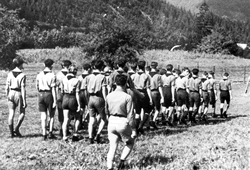 |
#H-030
A national - level Ha - Shomer ha - Tsa'ir course in defense and military skills, held in Mikulichin.
Catalog No.: 718
Type of Item: Photo
Databank: Youth Movements Photos
A national - level Ha - Shomer ha - Tsa'ir course in defense and military skills, held in Mikulichin. Photographed in September 1938. Note: This course was jointly organized by the national leadership of the Ha - Shomer ha - Tsa'ir youth movement and the He - Chaluts organization central's department ... |
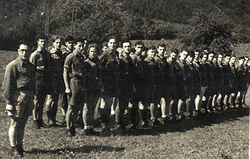 |
#H-031
A national - level Ha - Shomer ha - Tsa'ir course in defense and military skills, held in Mikulichin.
Catalog No.: 719
Type of Item: Photo
Databank: Youth Movements Photos
A national - level Ha - Shomer ha - Tsa'ir course in defense and military skills, held in Mikulichin. Photographed in September 1938. Note: This course was jointly organized by the national leadership of the Ha - Shomer ha - Tsa'ir youth movement and the He - Chaluts organization central's department ... |
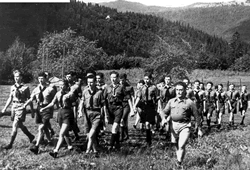 |
#H-032
A national - level Ha - Shomer ha - Tsa'ir course in defense and military skills, held in Mikulichin.
Catalog No.: 720
Type of Item: Photo
Databank: Youth Movements Photos
A national - level Ha - Shomer ha - Tsa'ir course in defense and military skills, held in Mikulichin. Photographed in September 1938. Note: This course was jointly organized by the national leadership of the Ha - Shomer ha - Tsa'ir youth movement and the He - Chaluts organization central's department ... |
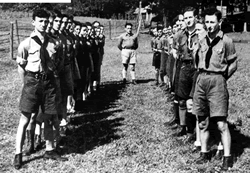 |
#H-033
A national - level Ha - Shomer ha - Tsa'ir course in defense and military skills, held in Mikulichin.
Catalog No.: 721
Type of Item: Photo
Databank: Youth Movements Photos
A national - level Ha - Shomer ha - Tsa'ir course in defense and military skills, held in Mikulichin. Photographed in September 1938. Note: This course was jointly organized by the national leadership of the Ha - Shomer ha - Tsa'ir youth movement and the He - Chaluts organization central's department ... |
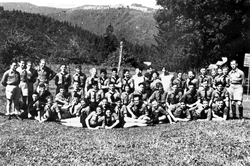 |
#H-034
Movement members and counselors in a national - level Ha - Shomer ha - Tsa'ir course in defense and military skills, held in Mikulichin.
Catalog No.: 722
Type of Item: Photo
Databank: Youth Movements Photos
Movement members and counselors in a national - level Ha - Shomer ha - Tsa'ir course in defense and military skills, held in Mikulichin. Photographed in September 1938. Note: This course was jointly organized by the national leadership of the Ha - Shomer ha - Tsa'ir youth movement and the He - Chaluts ... |
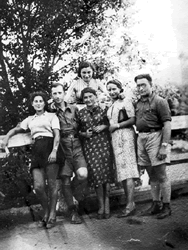 |
#H-035
Movement members participating in a national - level Ha - Shomer ha - Tsa'ir course in defense and military skills, held in Mikulichin.
Catalog No.: 723
Type of Item: Photo
Databank: Youth Movements Photos
Movement members participating in a national - level Ha - Shomer ha - Tsa'ir course in defense and military skills, held in Mikulichin. Photographed in September 1938. Note: This course was jointly organized by the national leadership of the Ha - Shomer ha - Tsa'ir youth movement and the He - Chaluts ... |
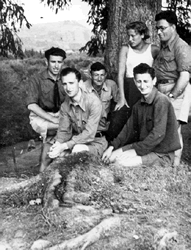 |
#H-036
Movement members participating in a national - level Ha - Shomer ha - Tsa'ir course in defense and military skills, held in Mikulichin.
Catalog No.: 724
Type of Item: Photo
Databank: Youth Movements Photos
Movement members participating in a national - level Ha - Shomer ha - Tsa'ir course in defense and military skills, held in Mikulichin. Photographed in September 1938. Note: This course was jointly organized by the national leadership of the Ha - Shomer ha - Tsa'ir youth movement and the He - Chaluts ... |
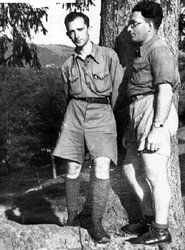 |
#H-037
Participants in a national - level Ha - Shomer ha - Tsa'ir course in defense and military skills, held in Mikulichin.
Catalog No.: 725
Type of Item: Photo
Databank: Youth Movements Photos
Participants in a national - level Ha - Shomer ha - Tsa'ir course in defense and military skills, held in Mikulichin. In the photo: Shabtai (full name unknown) and Menashe Amali. Photographed in September 1938. Note: This course was jointly organized by the national leadership of the Ha - Shomer ... |
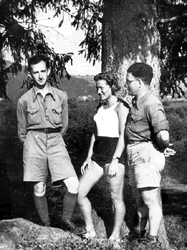 |
#H-038
Participants in a national - level Ha - Shomer ha - Tsa'ir course in defense and military skills, held in Mikulichin.
Catalog No.: 726
Type of Item: Photo
Databank: Youth Movements Photos
Participants in a national - level Ha - Shomer ha - Tsa'ir course in defense and military skills, held in Mikulichin. In the photo: Shabtai (full name unknown) and Menashe Amali. Photographed in September 1938. Note: This course was jointly organized by the national leadership of the Ha - Shomer .. |
 |
#H-039
Participants in a national - level Ha - Shomer ha - Tsa'ir course in defense and military skills, held in Mikulichin.
Catalog No.: 727
Type of Item: Photo
Databank: Youth Movements Photos
Participants in a national - level Ha - Shomer ha - Tsa'ir course in defense and military skills, held in Mikulichin. In the photo: Shabtai (full name unknown) and Menashe Amali. Photographed in September 1938. Note: This course was jointly organized by the national leadership of the Ha - Shomer ... |
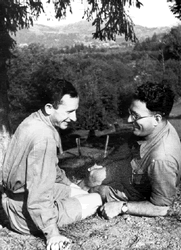 |
#H-040
Participants in a national - level Ha - Shomer ha - Tsa'ir course in defense and military skills, held in Mikulichin.
Catalog No.: 728
Type of Item: Photo
Databank: Youth Movements Photos
Participants in a national - level Ha - Shomer ha - Tsa'ir course in defense and military skills, held in Mikulichin. In the photo: Shabtai (full name unknown) and Menashe Amali. Photographed in September 1938. Note: This course was jointly organized by the national leadership of the Ha - Shomer ... |
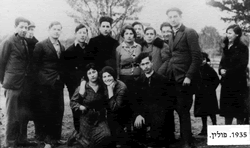 |
#H-041
Members of the Freiheit youth movement at a seminar of the He - Chaluts organization in Jozefow.
Catalog No.: 850
Type of Item: Photo
Databank: Youth Movements Photos
Members of the Freiheit youth movement at a seminar of the He - Chaluts organization in Jozefow. In the photo: Zivia Lubetkin (standing sixth from the left). Photographed in 1935. |
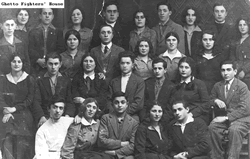 |
#H-042
A group of members of the He - Chaluts organization and the Freiheit youth movement in Baranowice.
Catalog No.: 938
Type of Item: Photo
Databank: Youth Movements Photos
A group of members of the He - Chaluts organization and the Freiheit youth movement in Baranowice. Photographed on November 1, 1931. |
 |
#H-043
A group of members of the He - Chaluts organization and the Freiheit youth movement in Baranowice.
Catalog No.: 939
Type of Item: Photo
Databank: Youth Movements Photos
A group of members of the He - Chaluts organization and the Freiheit youth movement in Baranowice. Photographed in 1930. |
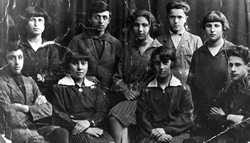 |
#H-044
A group of members of the He - Chaluts organization and the Freiheit youth movement in Baranowice.
Catalog No.: 940
Type of Item: Photo
Databank: Youth Movements Photos
A group of members of the He - Chaluts organization and the Freiheit youth movement in Baranowice. Photographed in 1928. |
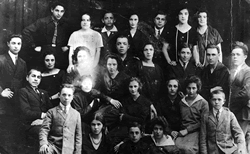 |
#H-045
A group of members of the He - Chaluts organization and the Freiheit youth movement in Baranowice.
Catalog No.: 941
Type of Item: Photo
Databank: Youth Movements Photos
A group of members of the He - Chaluts organization and the Freiheit youth movement in Baranowice. Photographed in 1929. |
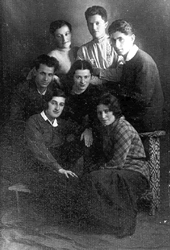 |
#H-046
A group of members of the He - Chaluts organization and the Freiheit youth movement in Baranowice.
Catalog No.: 942
Type of Item: Photo
Databank: Youth Movements Photos
A group of members of the He - Chaluts organization and the Freiheit youth movement in Baranowice. Photographed in 1930. |
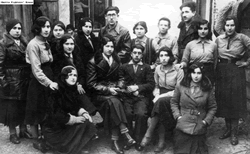 |
#H-047
A combined meeting of the steering committees of the Freiheit youth movement and the He - Chaluts organization in Czyzow.
Catalog No.: 1093
Type of Item: Photo
Databank: Youth Movements Photos
A combined meeting of the steering committees of the Freiheit youth movement and the He - Chaluts organization in Czyzow. Photographed on February 3, 1934. |
 |
#H-048
A combined meeting of the steering committees of the Freiheit and Po'alei Zion movements and the He - Chaluts organization in Czyzow.
Catalog No.: 1094
Type of Item: Photo
Databank: Youth Movements Photos
A combined meeting of the steering committees of the Freiheit and Po'alei Zion movements and the He - Chaluts organization in Czyzow. A map of Palestine is displayed on the table and on the wall behind the participants, portraits of Karl Marx and Dov - Ber Borochov. Photographed on September 8, 19 ... |
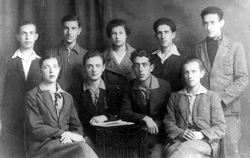 |
#H-049
A meeting of members of the He - Chaluts and Freiheit youth movements in Krakow.
Catalog No.: 1449
Type of Item: Photo
Databank: Youth Movements Photos
A meeting of members of the He - Chaluts and Freiheit youth movements in Krakow. Present at this meeting, which took place in 1933, was the emissary from Palestine Meir Grabowski. |
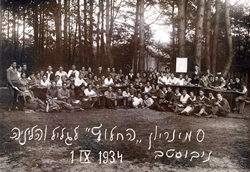 |
#H-050
A seminar of the He - Chaluts organization for members in the Volhynia district.
Catalog No.: 1499
Type of Item: Photo
Databank: Youth Movements Photos
A seminar of the He - Chaluts organization for members in the Volhynia district. The seminar was held in Nowostaw. Photographed on September 1, 1934. |
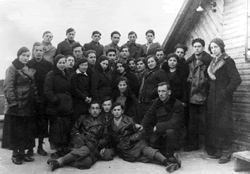 |
#H-051
A seminar of the He - Chaluts organization for members in the Bialystok district.
Catalog No.: 1500
Type of Item: Photo
Databank: Youth Movements Photos
A seminar of the He - Chaluts organization for members in the Bialystok district. The seminar was held in Ignatki. Photographed on April 4, 1935. |
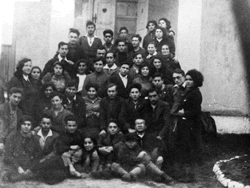 |
#H-052
Participants in a seminar of the He - Chaluts organization held in Jozefow in November 1934.
Catalog No.: 1501
Type of Item: Photo
Databank: Youth Movements Photos
Participants in a seminar of the He - Chaluts organization held in Jozefow in November 1934. |
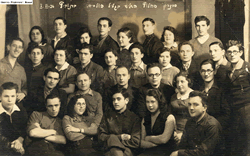 |
#H-053
Participants in the third seminar of the He - Chaluts organization in the Polesye district.
Catalog No.: 1502
Type of Item: Photo
Databank: Youth Movements Photos
Participants in the third seminar of the He - Chaluts organization in the Polesye district. The seminar was held in Baranowice. Photographed on February 1, 1936. Note: The photograph comes from the estate of Chaim "Lolek" Hadari, a Zionist emis |
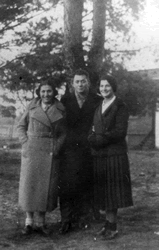 |
#H-054
Three participants in a seminar of the He - Chaluts organization held in Jozefow.
Catalog No.: 1503
Type of Item: Photo
Databank: Youth Movements Photos
Three participants in a seminar of the He - Chaluts organization held in Jozefow. Photographed on November 25, 1934. |
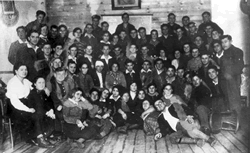 |
#H-055
Participants in a seminar of the He - Chaluts organization held in Jozefow in 1935.
Catalog No.: 1504
Type of Item: Photo
Databank: Youth Movements Photos
Participants in a seminar of the He - Chaluts organization held in Jozefow in 1935. |
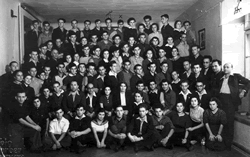 |
#H-056
Participants in a world seminar of the Zionist organization He - Chaluts held in Wola, near Warsaw, in 1938.
Catalog No.: 1505
Type of Item: Photo
Databank: Youth Movements Photos
Participants in a world seminar of the Zionist organization He - Chaluts held in Wola, near Warsaw (Warszawa), in 1938. Rachel Katnelson - Shazar was among the visitors to the seminar. In the photo: Yitzhak Tabenkin (third row from the top, third from the left). |
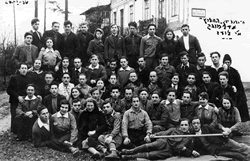 |
#H-057
Participants in a seminar of the He - Chaluts organization in Poland, held near Lodz.
Catalog No.: 1506
Type of Item: Photo
Databank: Youth Movements Photos
Participants in a seminar of the He - Chaluts organization in Poland, held near Lodz. The location was a building called "Villa Roma (Rome)." Photographed on January 26, 1936. |
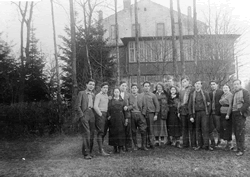 |
#H-058
Participants in a seminar of the He - Chaluts organization in Poland, held in January 1936.
Catalog No.: 1507
Type of Item: Photo
Databank: Youth Movements Photos
Participants in a seminar of the He - Chaluts organization in Poland, held in January 1936. Note: The seminar was evidently held in Jodlowa. |
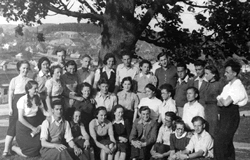 |
#H-059
Participants in an underground seminar of the He - Chaluts organization in Vilnius (Vilna).
Catalog No.: 1508
Type of Item: Photo
Databank: Youth Movements Photos
Participants in an underground seminar of the He - Chaluts organization in Vilnius (Vilna). The seminar was held during the Soviet occupation, in 1940. |
 |
#H-060
Members of a pioneering training commune of the He - Chaluts organization in Jedrzejow.
Catalog No.: 1509
Type of Item: Photo
Databank: Youth Movements Photos
Members of a pioneering training commune (kibbutz hachshara) of the He - Chaluts organization in Jedrzejow. In the photo: Zivia Lubetkin (standing third from the right). Photographed in 1935. Note: The hachshara in Jedrzejow belonged to the "Borochov" bloc. |
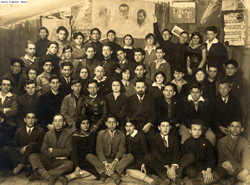 |
#H-061
Participants in a seminar of the He - Chaluts organization in Poland, held in 1930.
Catalog No.: 1510
Type of Item: Photo
Databank: Youth Movements Photos
Participants in a seminar of the He - Chaluts organization in Poland, held in 1930. The placard in the rear center of the photo has portraits of Joseph - Hayyim Brenner and Joseph Trumpeldor. |
 |
#H-062
Participants in a seminar of the He - Chaluts organization held in Grochow in 1933.
Catalog No.: 1511
Type of Item: Photo
Databank: Youth Movements Photos
Participants in a seminar of the He - Chaluts organization held in Grochow in 1933. |
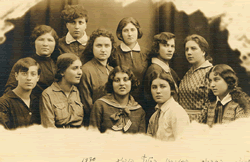 |
#H-063
A group of participants in a seminar of the Zionist organization He - Chaluts held in Warsaw in 1930.
Catalog No.: 1512
Type of Item: Photo
Databank: Youth Movements Photos
A group of participants in a seminar of the Zionist organization He - Chaluts held in Warsaw (Warszawa) in 1930. |
 |
#H-064
Participants in a seminar of the He - Chaluts organization in the Volhynia district.
Catalog No.: 1513
Type of Item: Photo
Databank: Youth Movements Photos
Participants in a seminar of the He - Chaluts organization in the Volhynia district. In the photo: Zvi Mersik (bottom row, seated third from the left). The seminar was held on November 13, 1936. |
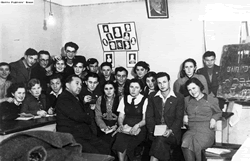 |
#H-065
Participants in a seminar of the He - Chaluts organization in December 1938.
Catalog No.: 1514
Type of Item: Photo
Databank: Youth Movements Photos
Participants in a seminar of the He - Chaluts organization in December 1938. It took place at the "Shachariya" kibbutz (commune) in Vileyka. The seminar leader was Josef Braslawski. In the photo: Shulamit Amitay, Sara Sokoler, Chana Zilbercwajg, Mordechai Tenenbaum - Tamaroff, Sarah Furman, Shimon ... |
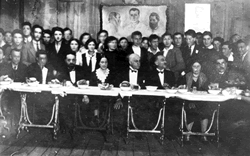 |
#H-066
The concluding festivities of a world seminar of the Zionist organization He - Chaluts.
Catalog No.: 1515
Type of Item: Photo
Databank: Youth Movements Photos
Participants at the concluding festivities of a world seminar of the Zionist organization He - Chaluts. The seminar took place in Warsaw (Warszawa). The celebration was held on January 5, 1931. |
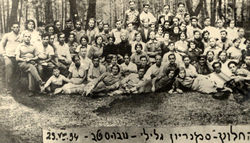 |
#H-067
Participants in a regional seminar of the He - Chaluts movement in Poland.
Catalog No.: 1516
Type of Item: Photo
Databank: Youth Movements Photos
Participants in a regional seminar of the He - Chaluts movement in Poland. The seminar was held in Nowostaw. Zivia Lubetkin was among the participants. Photographed on August 23, 1934. |
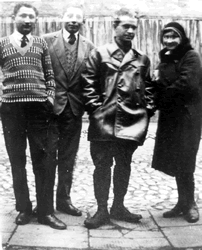 |
#H-068
Moshe Braslawski, a Zionist emissary from Kibbutz Beit Alfa in Mandate Palestine, at a world seminar of He - Chaluts in Warsaw
Catalog No.: 1517
Type of Item: Photo
Databank: Youth Movements Photos
Moshe Braslawski, an emissary from Kibbutz Beit Alfa in Mandate Palestine, at a world seminar of the Zionist organization He - Chaluts held in Warsaw (Warszawa). Photographed in September 1930. |
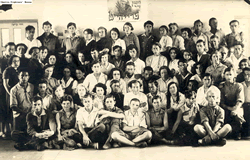 |
#H-069
Participants in the third national seminar of the He - Chaluts movement in Poland.
Catalog No.: 1518
Type of Item: Photo
Databank: Youth Movements Photos
Participants in the third national seminar of the He - Chaluts movement in Poland. The seminar was held in Grochow in May - June 1933. In the photo: a poster on the wall (in Yiddish) reads: Long Live Liberty. |
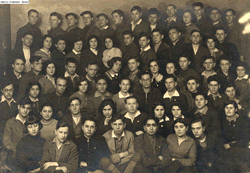 |
#H-070
The third national seminar for members of youth movements operating in the framework of the He - Chaluts movement in Poland.
Catalog No.: 1519
Type of Item: Photo
Databank: Youth Movements Photos
The third national seminar for members of youth movements operating in the framework of the He - Chaluts movement in Poland. The seminar took place in Jozefow. In the photo: Shlomo Tzam, Nachum Bielski, Zippora Schuster, Avraham Gewelber, Yoske Cohen, Zalman Avigdori, Shmuel Bruder, Zivia Lubetkin, ... |
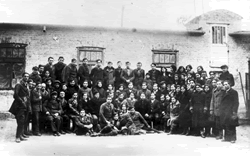 |
#H-071
A national seminar for members of the He - Chaluts movement, held in Jozefow.
Catalog No.: 1520
Type of Item: Photo
Databank: Youth Movements Photos
A national seminar for members of the He - Chaluts movement, held in Jozefow. In the photo: David and Chana Barash, who emigrated to Palestine before the seminar. Photographed on January 18, 1935. |
 |
#H-072
Members of the Zionist organization He - Chaluts who organized its seminar that was held in Warsaw in 1938.
Catalog No.: 1521
Type of Item: Photo
Databank: Youth Movements Photos
Members of the Zionist organization He - Chaluts who organized its seminar that was held in Warsaw (Warszawa) in 1938. In the photo: Shmuel - Mulka Baranchuk (on the right), Avraham Tarshish (center) and Yehoshua Wenger (on the left). |
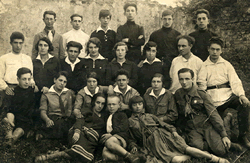 |
#H-073
Members of the He - Chaluts movement at a movement seminar held in Poland in 1928.
Catalog No.: 1522
Type of Item: Photo
Databank: Youth Movements Photos
Members of the He - Chaluts movement at a movement seminar held in Poland in 1928. The seminar took place at the Kajanka pioneering training center (hachshara). Seminar leaders included Zionist emissaries from Mandate Palestine: Nachum Ben Ari, Ch |
 |
#H-074
Participants in a seminar of the He - Chaluts movement in Poland in 1936.
Catalog No.: 1523
Type of Item: Photo
Databank: Youth Movements Photos
Participants in a seminar of the He - Chaluts movement in Poland in 1936. |
 |
#H-075
Participants in a seminar of the He - Chaluts movement.
Catalog No.: 1524
Type of Item: Photo
Databank: Youth Movements Photos
Participants in a seminar of the He - Chaluts movement. The seminar was held near Lodz, in a place called Arlamowek. Photographed on April 1, 1936. |
 |
#H-076
Five participants in a seminar of the Zionist organization He - Chaluts held in Warsaw in 1938.
Catalog No.: 1525
Type of Item: Photo
Databank: Youth Movements Photos
Five participants in a seminar of the Zionist organization He - Chaluts held in Warsaw (Warszawa) in 1938. In the photo: Mordechai Tenenbaum - Tamaroff (on the right). |
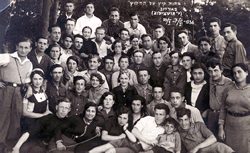 |
#H-077
A summer camp of the He - Chaluts movement held in Orlow.
Catalog No.: 1526
Type of Item: Photo
Databank: Youth Movements Photos
A summer camp of the He - Chaluts movement held in Orlow. The camp took place between May 29 and June 7, 1936. |
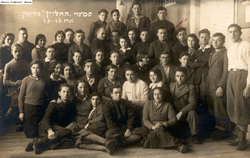 |
#H-078
Participants in a seminar of the He - Chaluts movement held in Pinsk.
Catalog No.: 1527
Type of Item: Photo
Databank: Youth Movements Photos
Participants in a seminar of the He - Chaluts movement held in Pinsk. This seminar was held between February 1 and March 1, 1935. |
 |
#H-079
A meeting of members of the He - Chaluts movement from the movement divisions in Myszkow and Zarki.
Catalog No.: 1528
Type of Item: Photo
Databank: Youth Movements Photos
A meeting of members of the He - Chaluts movement from the movement divisions in Myszkow and Zarki. Photographed on October 5, 1935. |
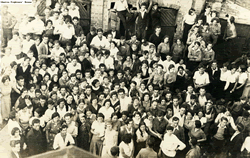 |
#H-080
A convention of members of the He - Chaluts movement from the Lutsk region.
Catalog No.: 1529
Type of Item: Photo
Databank: Youth Movements Photos
A convention of members of the He - Chaluts movement from the Lutsk region. The convention was held on September 9 - 10, 1934. |
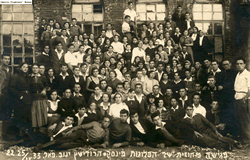 |
#H-081
A regional convention of divisions of the He - Chaluts movement from Pinsk, Gorodishche, Janow and Falenica.
Catalog No.: 1530
Type of Item: Photo
Databank: Youth Movements Photos
A regional convention of divisions of the He - Chaluts movement from Pinsk, Gorodishche, Janow and Falenica. The convention took place between September 22 and 25, 1933. Identified: Cila Gelman. |
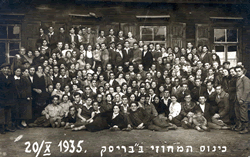 |
#H-082
A convention of pioneering training communes of the He - Chaluts movement in the Brest (Brest Litowsk, Brist) region.
Catalog No.: 1531
Type of Item: Photo
Databank: Youth Movements Photos
A convention of pioneering training communes (kibbutzei hachshara) of the He - Chaluts movement in the Brest (Brest Litowsk, Brist) region. Photographed on October 20, 1935. Note: The photograph comes from the estate of Chaim "Lolek" Hadari, a |
 |
#H-083
Participants in the regional conference of the Ha - Oved movement's local chapters in the framework of the He - Chaluts movement in Poland.
Catalog No.: 1532
Type of Item: Photo
Databank: Youth Movements Photos
Participants in the regional conference of the Ha - Oved movement's local chapters in the framework of the He - Chaluts movement in Poland. Note: The Ha - Oved [Hebrew: the worker] movement's members were graduates of the He - Chaluts movement, largely craftsmen and skilled workers who had settled ... |
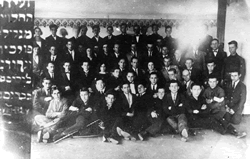 |
#H-084
A regional conference of local chapters of the He - Chaluts movement from the Polesye, Grodno and Bialystok districts.
Catalog No.: 1533
Type of Item: Photo
Databank: Youth Movements Photos
A regional conference of local chapters of the He - Chaluts movement from the Polesye, Grodno and Bialystok districts. This conference was held in Brest (Brest Litowsk; Brisk) in 1924. |
 |
#H-085
A convention of members of the He - Chaluts movement in Lomza.
Catalog No.: 1534
Type of Item: Photo
Databank: Youth Movements Photos
A convention of members of the He - Chaluts movement in Lomza. The convention was held in 1930 or 1931. |
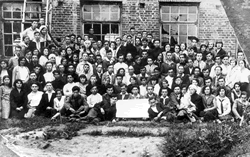 |
#H-086
A regional convention of the He - Chaluts movement held in Pinsk.
Catalog No.: 1535
Type of Item: Photo
Databank: Youth Movements Photos
A regional convention of the He - Chaluts movement held in Pinsk. In the photo: Herschel Pinski and Yitzhak Tabenkin. Photographed in 1930. |
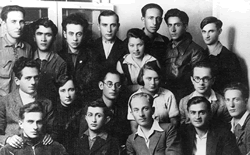 |
#H-087
Members of the Zionist organization He - Chaluts, attending its convention held in Warsaw in 1935
Catalog No.: 1536
Type of Item: Photo
Databank: Youth Movements Photos
Members of the Zionist organization He - Chaluts, attending its convention held in Warsaw (Warszawa) in 1935. |
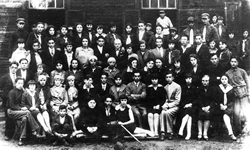 |
#H-088
A meeting of members of the He - Chaluts movement.
Catalog No.: 1537
Type of Item: Photo
Databank: Youth Movements Photos
A meeting of members of the He - Chaluts movement. This meeting took place in Korelichi, neaer the elementary school, on July 7, 1929. |
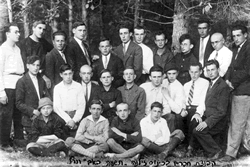 |
#H-089
Members of the He - Chaluts movement at a convention held in Zielun.
Catalog No.: 1538
Type of Item: Photo
Databank: Youth Movements Photos
Members of the He - Chaluts movement at a convention held in Zielun. The convention took place on Tisha B'Av, August 3, 1930. |
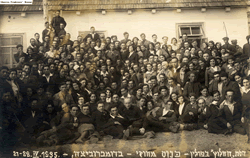 |
#H-090
A regional convention for members of the He - Chaluts movement.
Catalog No.: 1539
Type of Item: Photo
Databank: Youth Movements Photos
A regional convention for members of the He - Chaluts movement. The convention was held in Dubrovitsa on April 21 - 22, 1935. |
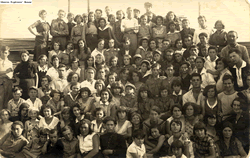 |
#H-091
A convention for members pioneering training communes of the He - Chaluts movement in the Klesov (Klosova) area.
Catalog No.: 1541
Type of Item: Photo
Databank: Youth Movements Photos
A convention for members pioneering training communes (kibbutzei hachshara) of the He - Chaluts movement in the Klesov (Klosova) area. Participants in the convention came from the cities of Dubrovitsa, Sarny and Rokitnoye (Rokitno). The convention |
 |
#H-092
The second convention on ideology for members of the He - Chaluts movement in the "Northern Bloc" of Poland.
Catalog No.: 1542
Type of Item: Photo
Databank: Youth Movements Photos
The second convention on ideology for members of the He - Chaluts movement in the "Northern Bloc" of Poland. Two emissaries from Palestine participated in the convention: Czerna Friedman and one named Zvik. The convention was held in Plock on March 8 - 9, 1935. |
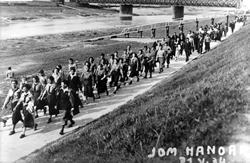 |
#H-093
A march of members of the He - Chaluts movement in Krakow on International Youth Day, May 21, 1934.
Catalog No.: 1540
Type of Item: Photo
Databank: Youth Movements Photos
A march of members of the He - Chaluts movement in Krakow on International Youth Day, May 21, 1934. |
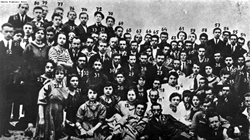 |
#H-094
Participants in a congress of the Zionist organization He - Chaluts held in Warsaw
Catalog No.: 1543
Type of Item: Photo
Databank: Youth Movements Photos
Participants in a congress of the Zionist organization He - Chaluts held in Warsaw (Warszawa). The congress was held on July 27 - 30, 1921. |
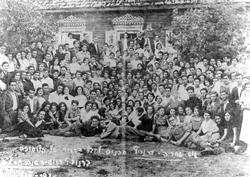 |
#H-095
Members of the He - Chaluts movement in Baranowice at a festive convention marking a decade of the pioneering training center at Klesov (Klosova).
Catalog No.: 1544
Type of Item: Photo
Databank: Youth Movements Photos
Members of the He - Chaluts movement in Baranowice at a festive convention marking a decade of the pioneering training center (hachshara) at Klesov (Klosova). The convention was held at the Jewish New Year, on September 10, 1934. |
 |
#H-096
The speakers' table at the 12th Conference of the He - Chaluts movement in Galicia.
Catalog No.: 1545
Type of Item: Photo
Databank: Youth Movements Photos
The speakers' table at the 12th Conference of the He - Chaluts movement in Galicia. This conference was held in Lvov on December 24, 1933. |
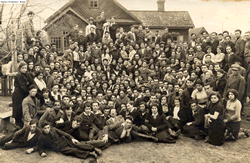 |
#H-097
A convention of members of a pioneering training center of the He - Chaluts movement in Baranowice.
Catalog No.: 1546
Type of Item: Photo
Databank: Youth Movements Photos
A convention of members of a pioneering training center (hachshara) of the He - Chaluts movement in Baranowice. The convention was held during Passover. |
 |
#H-098
A convention in Bedzin of members of the He - Chaluts movement.
Catalog No.: 1547
Type of Item: Photo
Databank: Youth Movements Photos
A convention in Bedzin of members of the He - Chaluts movement. The convention was held in 1936. |
| |
|
| |
|
| |
|
| |
|
| |
|

